Insider’s Guide to Graz: Things to Do in (and Beyond) the Unesco Old Town
This website uses affiliate links which may earn a commission at no additional cost to you. As an Amazon Associate I earn from qualifying purchases.
Updated: 9th December 2024
Graz is Austria’s second-largest city, but it’s super laid back – I’d go as far as describing it as a ‘grand city with a countryside soul’. Surrounded by the fruitful farmlands and vineyards of Styria, it’s a Starbucks-free kind of place where independent and sustainable social-impact stores, zero-waste restaurants, and straight-from-the-harvester’s-hands farmers markets still rule the town.
While many visitors concentrate on Graz’s historic World Heritage-listed core, there’s much more to explore beyond the Old Town. With a student-heavy population, a significant focus on community and sustainability – over 60% of the city is green – and plenty of interesting up-and-coming districts, there’s plenty to explore in one of Austria’s best cities.
Awarded the European Capital of Culture in 2003, the city has seen plenty of modern architecture and creativity ooze into its already forward-thinking soul since then. It’s not a place where old versus new, though; rather, a city where classics sit alongside the contemporary in a complementary – rather than contrasting – way.
I’ve been privileged enough to visit Graz a few times and meet many of the city’s makers, producers, hoteliers and creatives who have been kind enough to share their insider Graz tips and thoughts, which are dotted throughout this guide alongside all of my favourite bars, restaurants, hotels, attractions, sights, nearby day trips and things to do on a weekend in Graz. Be sure to save some time so you can meet Graz’s makers yourself to get even more local insights – and say hello from me!

“My Graz highlight? I think the size. Because it’s nearly big enough to be a city, but it’s small enough to be a village.”
–Eva Berghofer, Owner Coffee Ride
What is Graz famous for?
Graz is famous for its culinary scene – especially being a gateway to the farmlands of Styria – and its design credentials. It’s one of only two cities in Europe (the other being Berlin) that have been awarded UNESCO status as both a City of Design and for its ancient core, making it quite unique architecturally and culturally.
The city has also played an essential role in the country’s history and has seen a fair share of struggles. From its crucial defensive position against the Ottoman Empire to the Napoleonic invasion in the early 19th century when important monuments were destroyed, the past hasn’t always been smooth sailing. Though walking the student-heavy and peaceful streets these days, it’s hard to imagine the dramas of times gone by – that is, until you visit the incredibly well-equipped historic armoury of the city, one of the most famous things to do in Graz. All things considered, though, it does remain of the more underrated cities in Europe.

“You’ve got greenery. You’ve got buildings from every century. You’ve got good restaurants. You’ve got the countryside around, you don’t have to sit in a car to get to the countryside, you’re basically in the countryside. You can go by tram and you’re then already walking in the mountains in the north of Graz. That’s the reason I came to live here. That’s what attracted me so much.”
–Helen Petermandl, Tour Guide
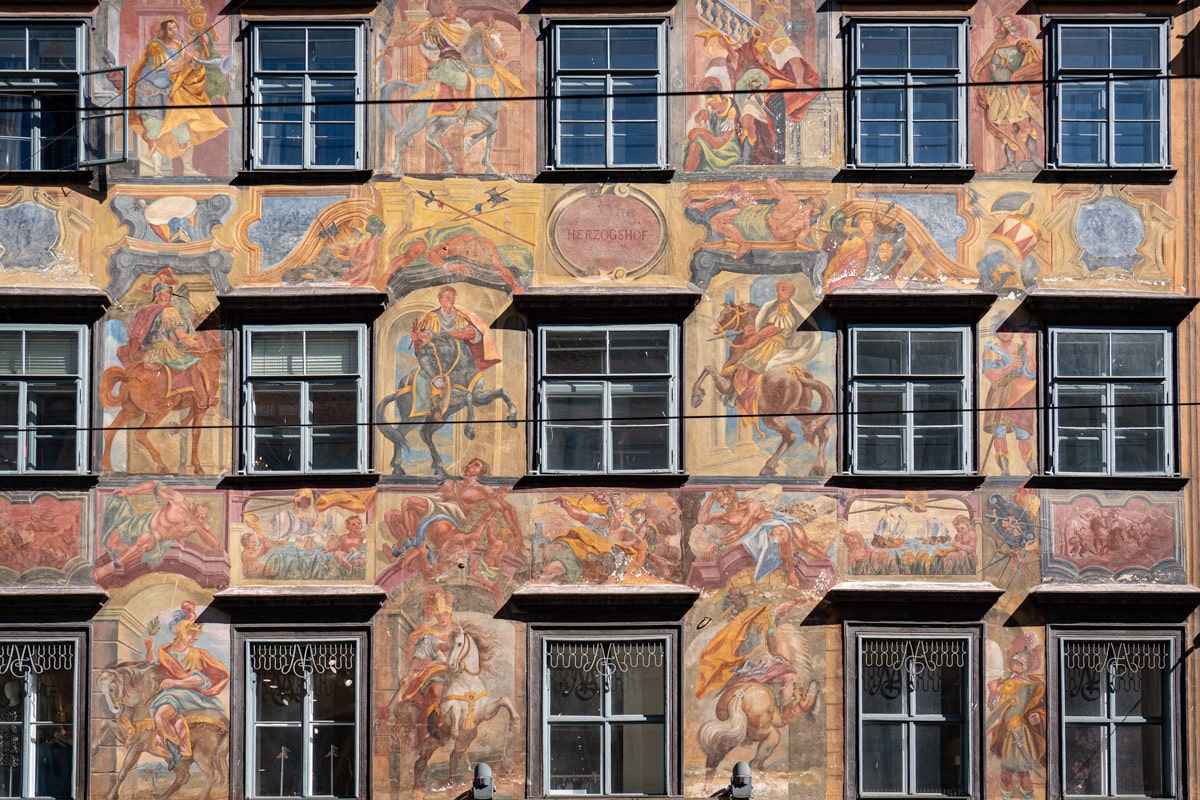
How many days do I need in Graz?
If you just want a quick overview of the main attractions in the UNESCO Old Town and the top things to do in Graz, you could likely ‘do Graz’ in one long day. That said, unless you’re really pushed for time, I’d suggest staying at least two nights to soak up the city’s atmosphere. Graz is one of those places where it is just a pleasure to be and explore slowly, and there’s plenty nearby to keep you entertained if you fancy some day trips. Keep in mind if you plan to spend a few days in the city and visit a handful of attractions, the Graz Card might save you some cash.
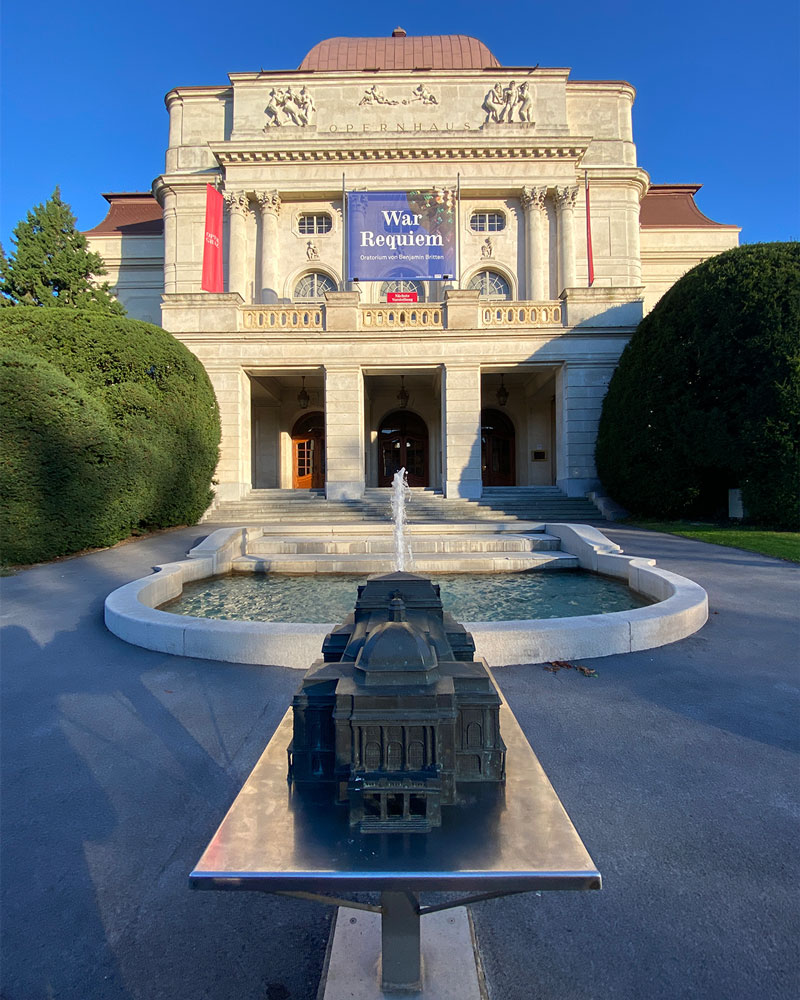
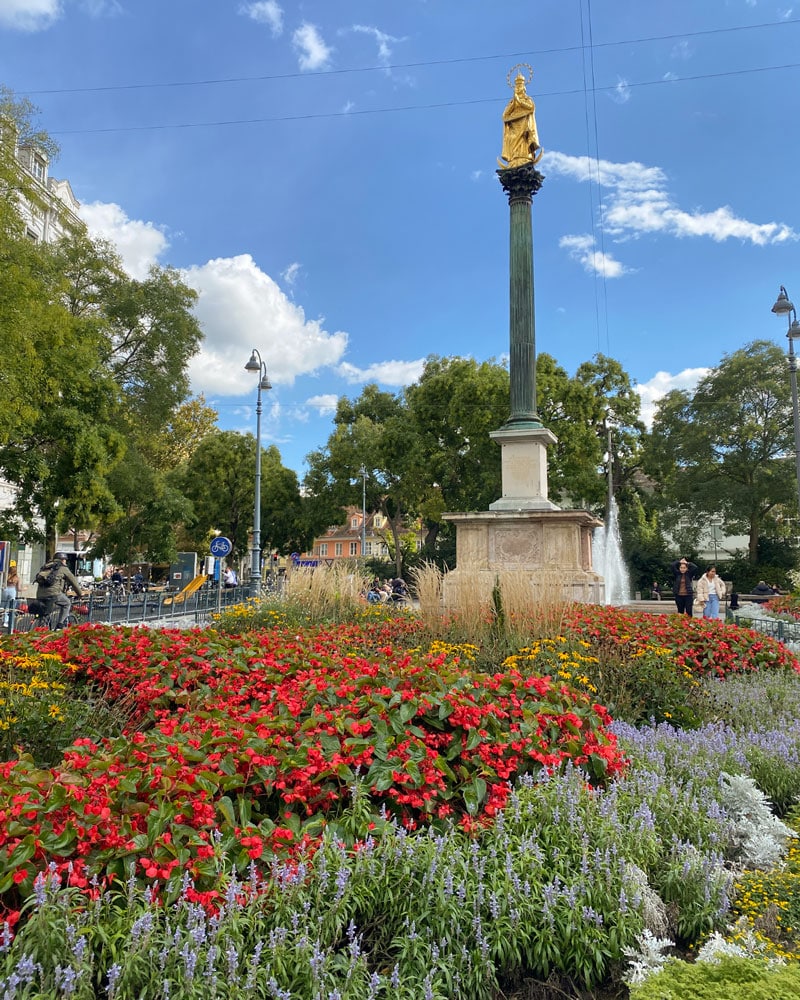
Where to stay in Graz
Graz hasn’t seen the tourism boom of Vienna, Salzburg, or even Innsbruck in the summertime, which means the number of hotel beds in the city is only around 6000 – you’ll want to book ahead.
Sishaus Hostel €
Laid-back hostel with plenty of light wood and airy vibes – one of the city’s few more ‘budget’ options. While there is also an a&o hostel, I find them a bit bland and all the extra charges frustrating So, I would opt for this more charismatic option. View on booking.com
Parkhotel €€
I adore this fourth-generation family-run hotel. For 450 years, it’s been providing lodging, and although in recent years it’s had some upgrades, such as a dreamy swimming pool and upscale restaurant, it retains many of its original features. A grand staircase, wood-panelled dining, and delightfully decorated and spacious suites make this an excellent choice. It’s named for the green areas surrounding it, and you’ll be less than a 15minute walk, or quick tram hop, from the Old Town. View on booking.com

“Family-owned businesses need to remain. It’s very important for every city, for every place, because in the end, take my family; we aren’t only investors here. This is our place, our home, and we’re citizens here. We’re part of the city and the city is part of us.”
–Philip Florian, General Manager Parkhotel
Hotel Gollner €€
This really welcoming, family-run hotel is where I stayed on my most first visit. Spread out across a few buildings where it’s expanded over the years. It has a good restaurant, a lovely rooftop with some views of the clocktower when standing, and really friendly staff. They’ll even welcome you with a little cake shaped like the city’s clock tower. View on booking.com
Lendhotel €€
Modern option in the trendy Lend district. The rooms are light and spacious; there’s bike hire and a 24-hour desk, plus a roof terrace to relax on. View on booking.com
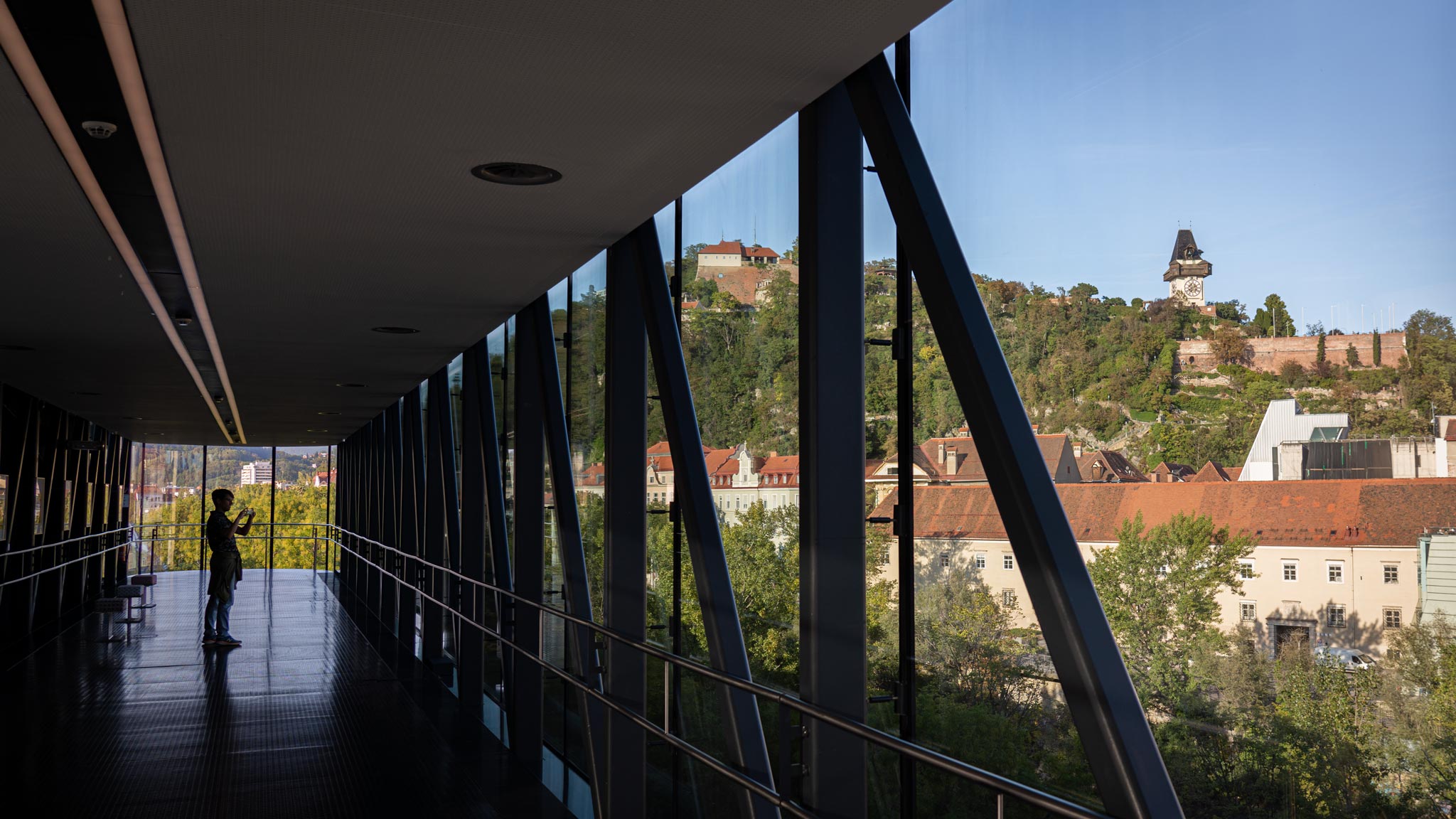
Graz travel guide: things to do in Graz
Graz is a city that deserves to be delved into, so while you should absolutely make time for the top things to do in Graz and the city’s most famous attractions, such as the Clock Tower and UNESCO Old Town, In this Graz travel guide I’ve tried to also highlight some of the things I really loved away from the historic core as I slowed down and explored sustainable Graz.
Tour the UNESCO-listed Old Town and Courtyards
If Vienna has coffee culture, Graz has courtyard culture. These delightful spaces are linked together with Medieval shortcuts, usually with a tucked-away wine bar or cafe as a reward for taking the next turn. In fact, there are more than 50 inner courtyards in the city, and getting lost amongst them is one of Graz’s greatest joys.
The grandest of them all is Grazer Landhaus, the seat of the provincial government. A masterpiece in Italian Renaissance arcade architecture, it’s here you really see the city’s Mediterranean influence shine through.
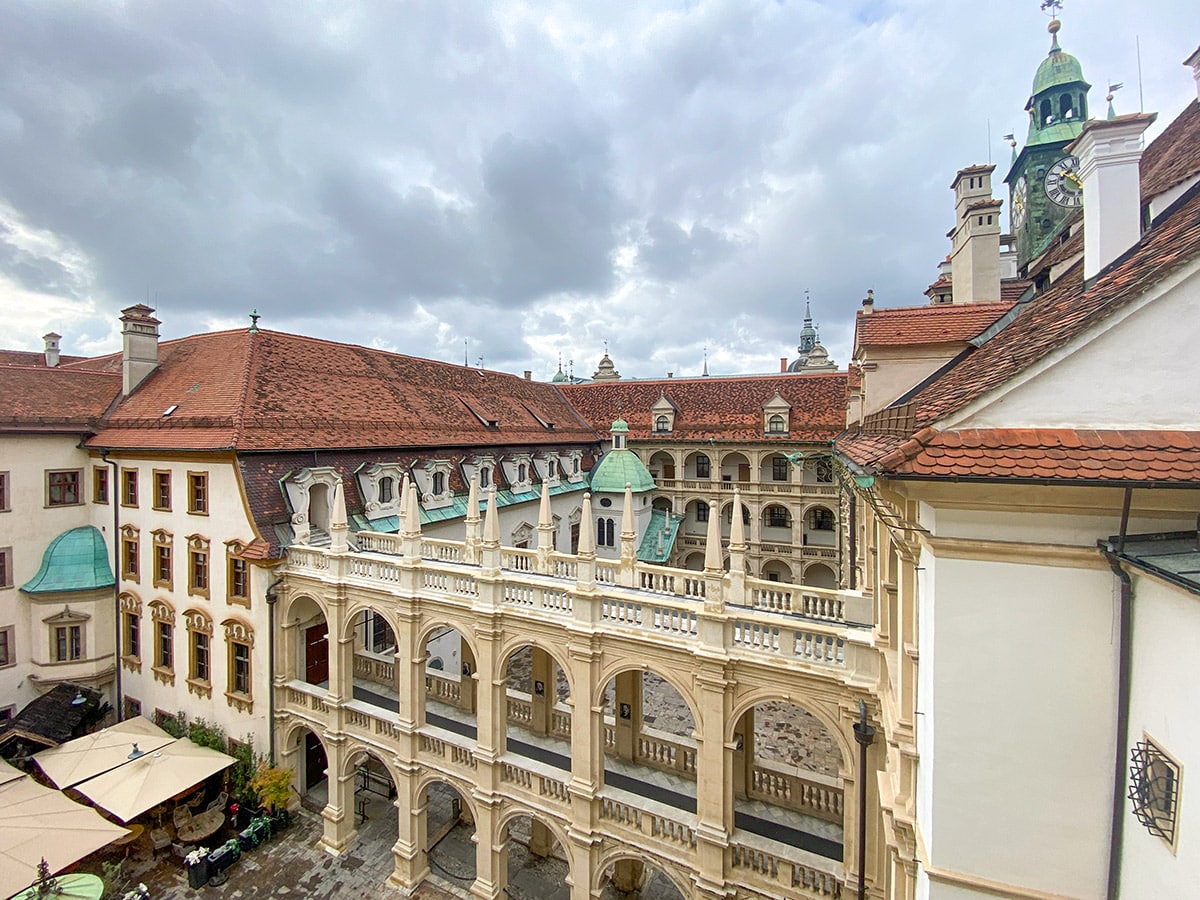
Outside of the labyrinth of enclosed squares, the rest of the Old Town dazzles in perfectly maintained glory. Mainly Medieval in appearance, most houses date back to between the 13th and 16th centuries when Graz was at its peak. Unlike some European Old Towns which Airbnb has taken over, Graz’s centre is very much for the locals, which makes the atmosphere less touristy – something we can thank the rent controls for.
Another spot to just hang out is on Hauptplatz, the main square, which is flanked by highly detailed and colourful facades, the Rathaus (the town hall), and is looked down on by the Uhrturm.

“There are some nice hidden places so you can for sure have a walk and see the Cathedral and everything, but in my opinion the places which are very very nice are the the courtyards. There are some hidden places, you have to not be scared to go inside the courtyards”
–Philip Florian, General Manager Parkhotel
Cross the Murinsel
Free (Cafe paid) | Open daily | Wheelchair accessible | Save on Google Maps
Flowing through the centre of Graz is the River Mur, home to its own artificial island, the Murinsel, now one of the top things to do in Graz. Originally designed and intended for the Hudson River in New York, the glass and steel floating structure links the river’s banks by two bridges meeting at a central platform.
Placed here as part of Graz’s European Capital of Culture in 2003, it was initially meant to stay on a ten-year loan before heading to the United States, though 20 years later, it remains. A testament to how the locals have grown fond of the space, which now houses a cafe, art displays, and serene seating areas.
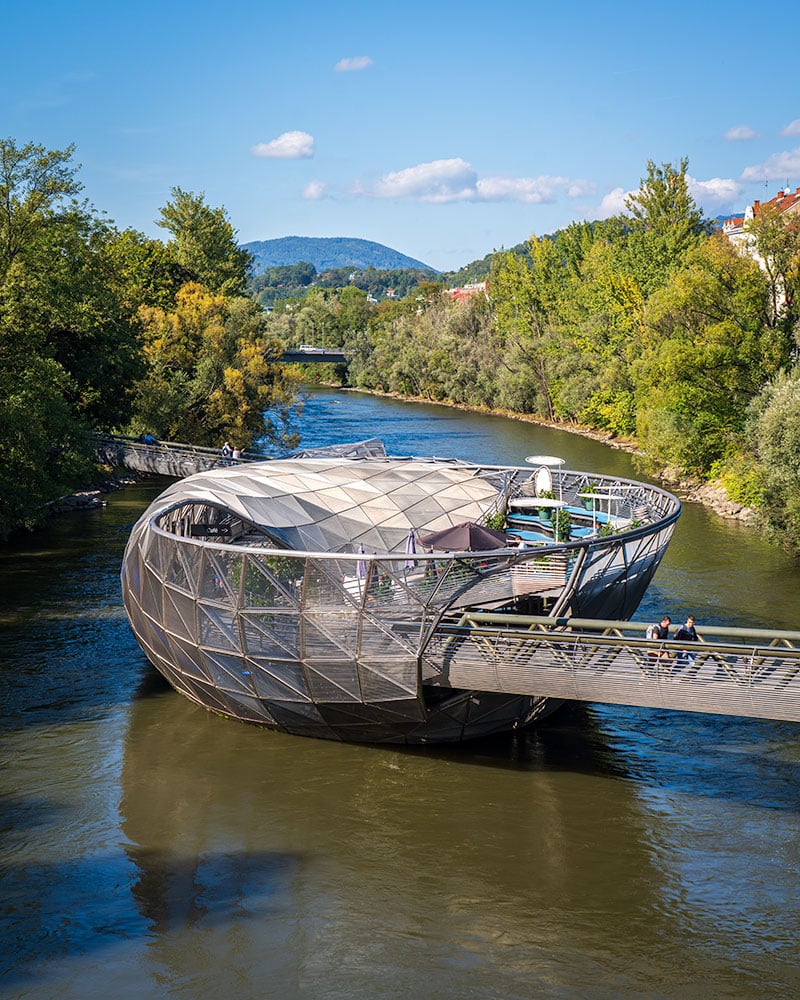
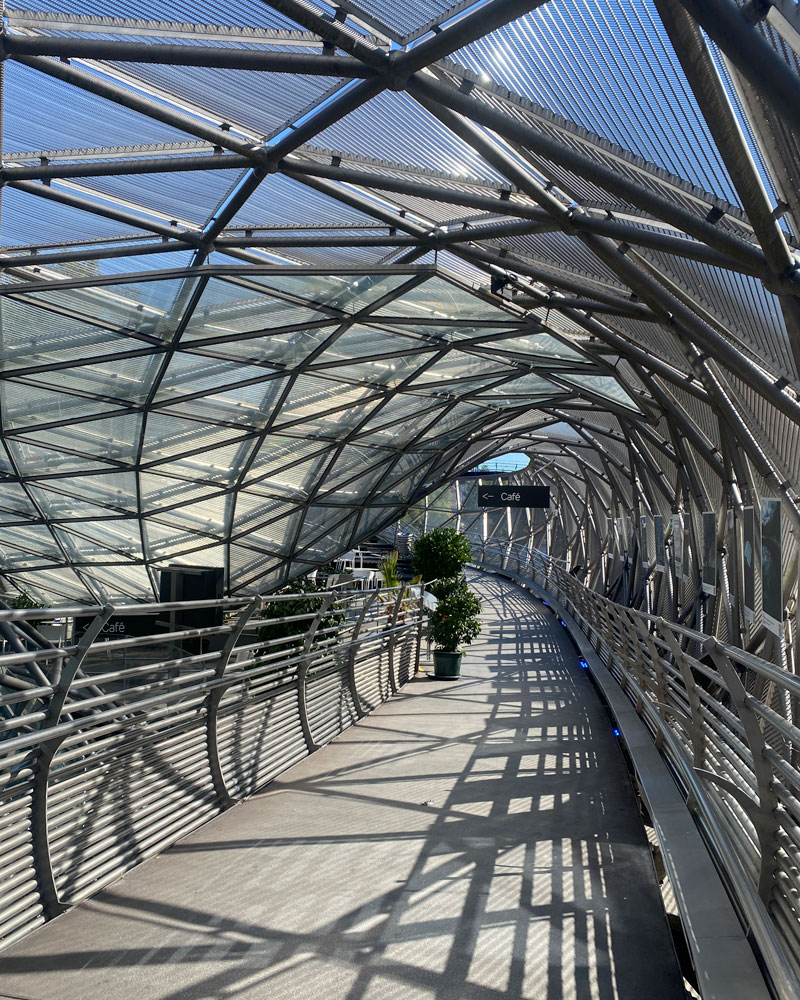
Visit the Kunsthaus (Modern Art Gallery)
Paid | Open daily | Wheelchair accessible | Save on Google Maps
Graz’s Modern Art gallery – another legacy of the European Capital of Culture – caused quite a stir when it opened, so much so that residents were actively invited to visit during the construction stage to win them over.
Given that the Kunsthaus has since earned the nickname of The Friendly Alien, it’s fair to say it has now won enough fans. With a unique exterior shape, bursting at the sides and with curved ‘tentacles’ atop, it really stands out against the classical buildings beyond and is one of the reasons Graz is a UNESCO City of Design.
It’s hard to appreciate the design from the outside, but a bronze accessibility model out the front allows you to understand the design. These mini-statues appear outside all of Graz’s key attractions, allowing those with eyesight impediments to feel the shape of the city’s architecture.
Inside, the multi-floored space is home to temporary and permanent exhibitions of modern and contemporary art, and the viewing platform on the top floor has some of the best views of the Old Town. Every hour – or rather, 10 minutes to the hour – the building emits a strange noise, and by night, the outside turns into a giant LCD screen. It’s now a firm favourite on most Graz travel guides, and for good reason.

“It had quite a legacy for the city when it was the European Captain of Culture. In my remembrance, it changed things. The interest of Graz people in culture grew and grew, and it was a very successful project in every point of view.”
–Mathis Huber, Intendant of Styriaarte
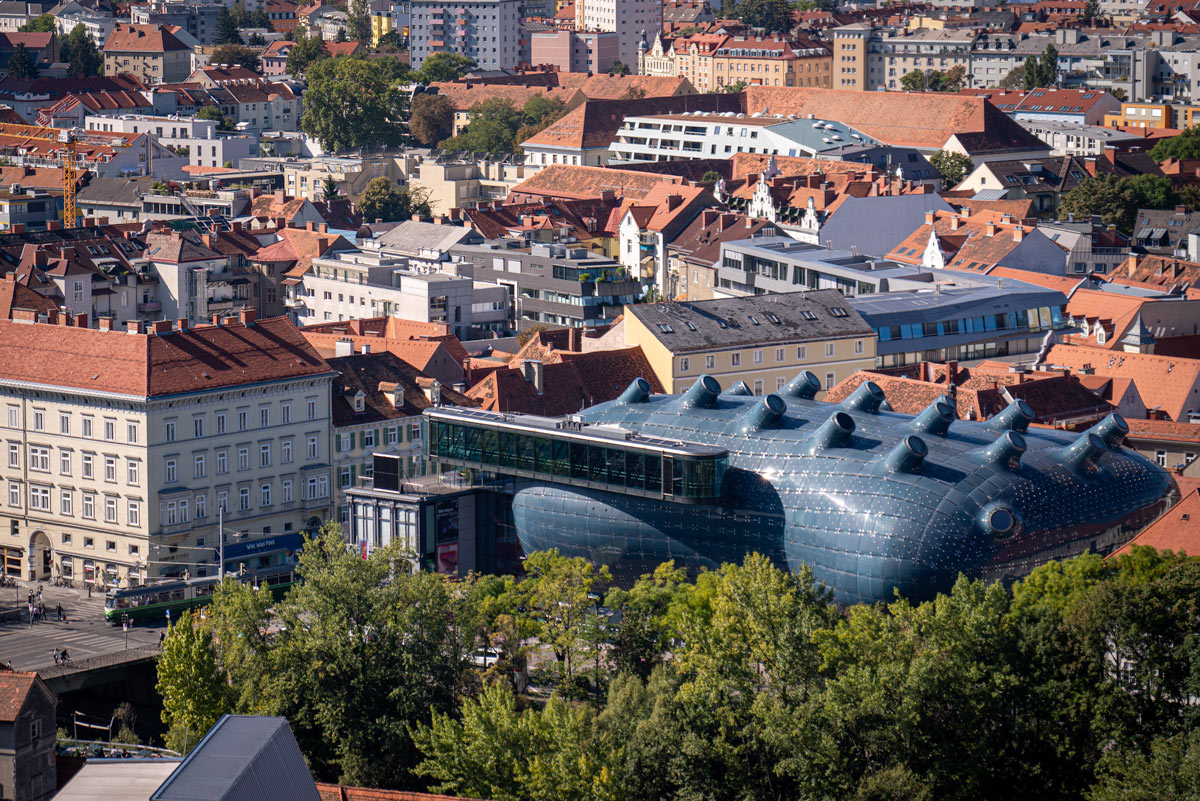
Explore the Gries and Lend districts
Graz’s ‘other side’ was long an area avoided. If the Old Town was for nobility and the affluent, the districts of Gries and Lend were historically seen as for the shady, with bars, brothels and traders constantly passing through.
While perhaps not all of that reputation has entirely dissolved, the districts are now starting to face gentrification. Still, they make for a welcome change of scene to the polished Old Town, with independent boutiques, restaurants with flavours from around the world, and plenty of second-hand bargains to be found. This is a part of the city you venture to just to enjoy the atmosphere rather than to tick off sights, but for me, at least, that made it even more enjoyable.

“The district of Lend, in my opinion, is very nice. There is a lot of small shops and a lot of small cafes with good food and nice people.”
–Jonathan Strallegger, Founder VeloFood

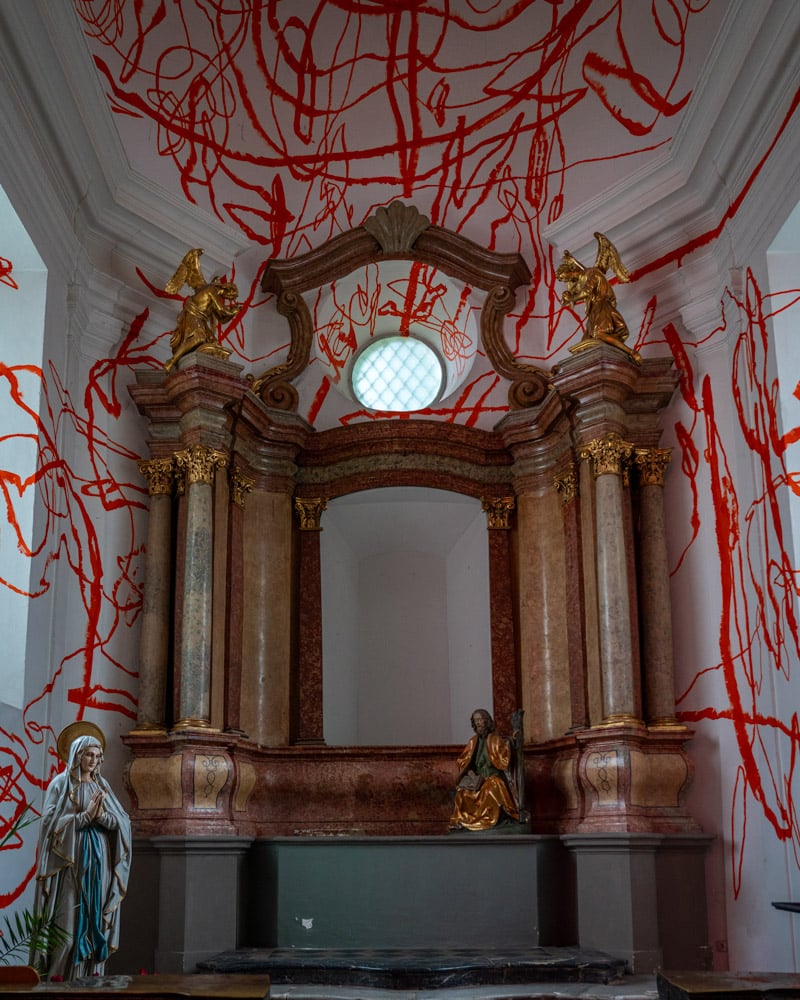
Admire St. Andrä Art Church
Free | Hours vary | Save on Google Maps
You’ll find plenty of grand churches and religious monuments in Graz – it’s Europe, after all! – but the Andrä Art Church in Lend is something a little different.
At first glance, you’d likely think it was a decommissioned church turned into an art gallery, thanks to the words decorating the exterior, but it’s still very much in service. While it’s hard to imagine attending a mass here due to the red graffitied ceiling and traditional altar alongside the more contemporary art pieces, it’s a good characterisation of Graz’s focus on community and youth.
For something a little more traditional, there are plenty of other religious monuments worth visiting, often billed as some of the best things to do in Graz. Spots such as the Basilika Mariatrost, the city’s Mausoleum, and the Gothic Franciscan Monastery – the garden of the latter being a cool and peaceful place to stop and read on a summer’s day – are worth a visit if time allows.

“Every Sunday, we host a mass in both Pidgeon and Spanish due to the Latin and Nigerian communities in the neighbourhood, and once a month, we all celebrate together with an international mass. It’s not necessary to be a religious artist to decorate here, but to be a good artist.”
–Alois Kölbl, Counsellor of St. Andrä Church
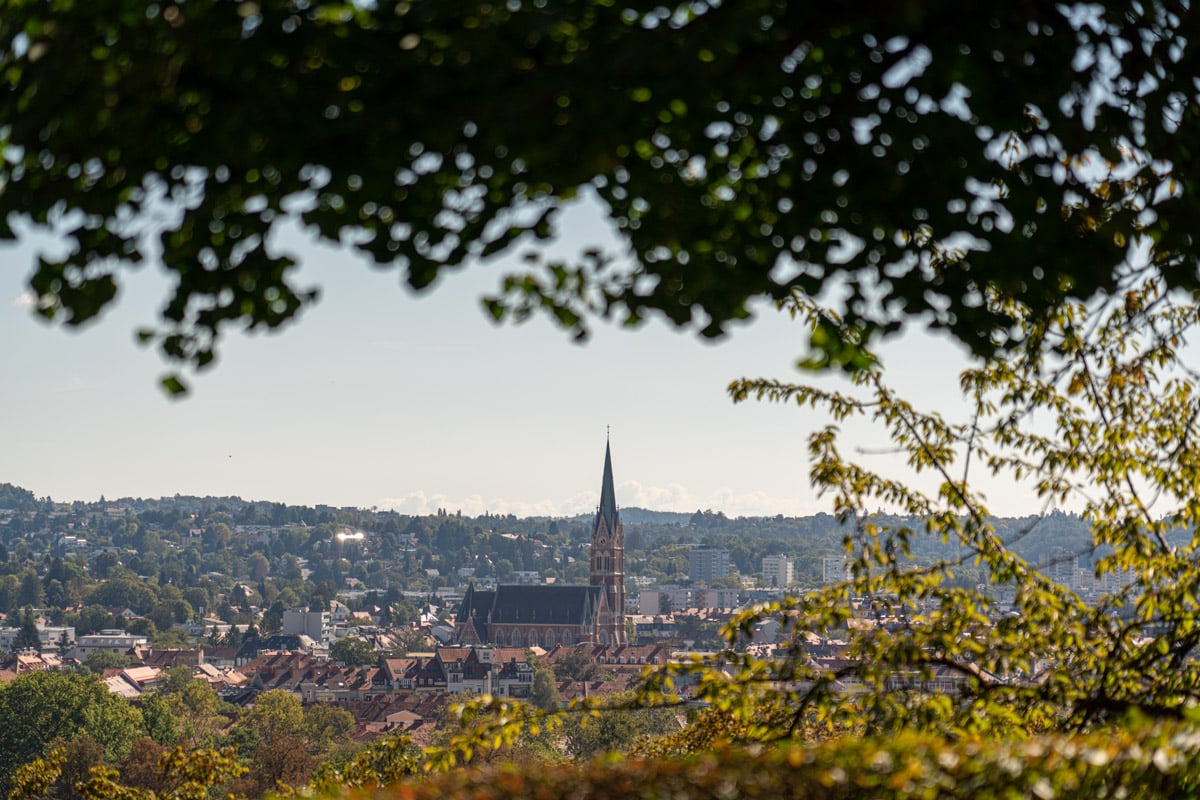
Head up the Schlossberg
Free | Open daily | Wheelchair accessible paid lift and funicular | Save on Google Maps
For centuries, the Schlossberg, a verdant 473-metre dolomite hill in the centre of the city, was crowned by a fortress built over 1000 years ago. While Napoleon demanded the fortress be destroyed in 1809, leaving just remnants today, the space was reimagined a short time later as a green park right in the city’s heart. With trails, bars and cafes all offering incredible panoramas over church spires and into the forests and farmlands of Styria beyond, the views are reason enough for doing the climb.
Luckily, there are a few options for getting to the top, the easiest being an elevator and funicular, or you can climb the zig-zag hill or the imposing 260-step staircase. If you take the hill route, you can still see a tunnel system used in WWII as an air raid shelter – now acting as a passageway and shortcut under the mound.

“It [the Flight Graz 4D Motion Ride] moves around like you’re flying through the city and I love it. A drone filmed it at 60 kilometres an hour, so you’re going over the river, and you’re getting the spray of the river, and you’re going up the double spiral stairs and flying over the roofs and in and out, and you’re seeing Graz from a fly’s perspective. It’s probably a little bit easier than the slide going down. You have to be a little bit brave to go on that slide”
–Helen Petermandl, Tour Guide
Check out (and slide down from) the Uhrturm
Slide is paid | Open daily | Save on Google Maps
Graz is a city big on tradition and community, and perhaps the most prominent symbol of this is also the symbol of the city – the clock tower dating from 1560. When Napoleonic troops destroyed the rest of the Schlossberg, the residents all came together to pay a ransom to protect their beloved clock tower from the same fate. Now, it stands high above, a forever reminder of a city with not just a countryside soul but a proud one.
The clock tower has a few curious features, most noticeable the face. Initially, it only displayed hours, thus only needing one long hand, but when minutes were added later, the decision was taken to add a small hand to do so, leaving it in reverse to a standard clock. When you’ve finished exploring the Schlossberg, there’s a slide just by the Uhrturm you can pay a few euros to take to the bottom – it’s a pretty fast and long ride down – and one of the most fun things to do in Graz especially if you’re travelling with kids.
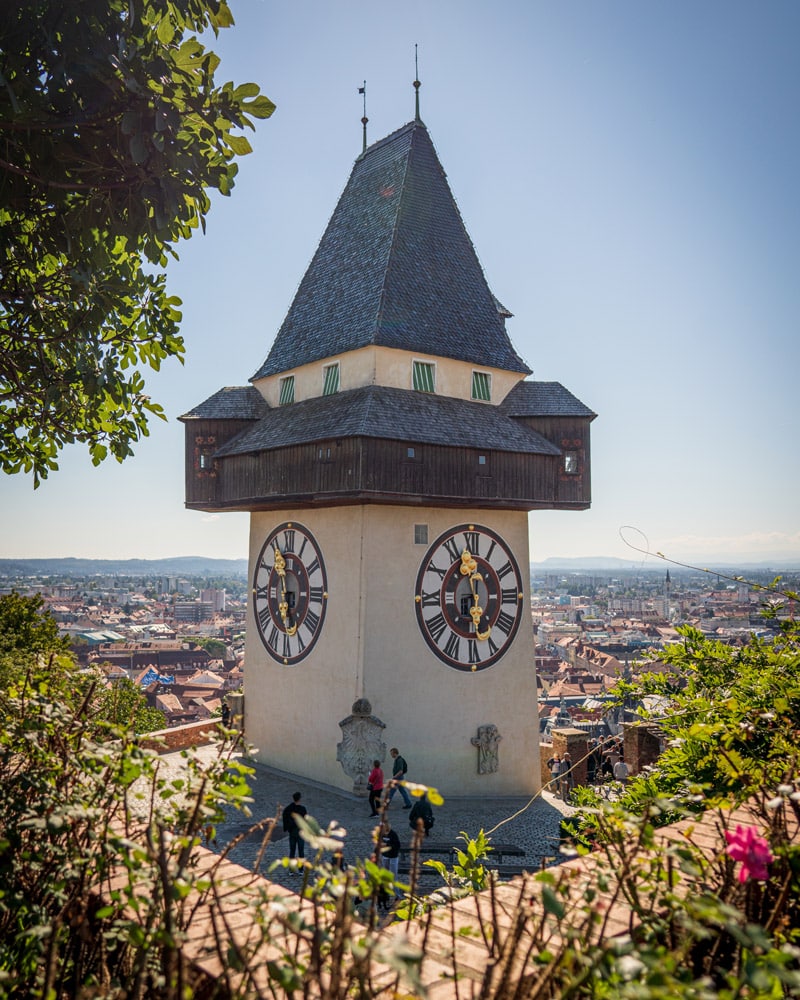
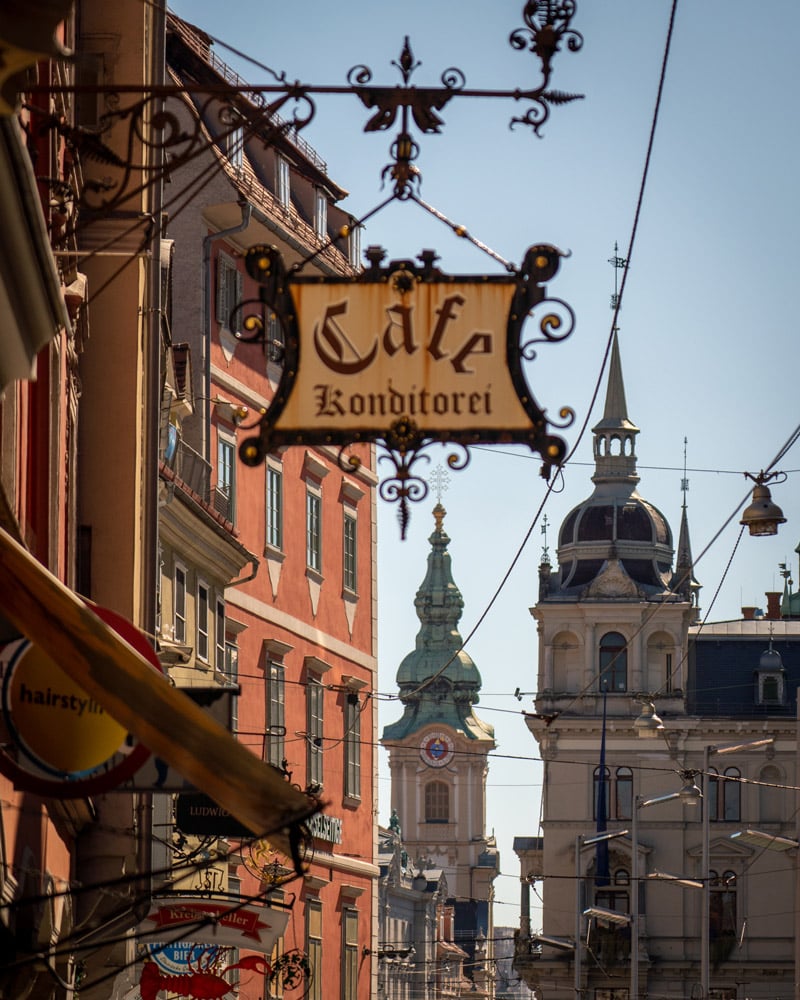
Take a fascinating guided tour
Graz might seem compact, but it has plenty of secrets and secluded spots. Sure, some you’ll stumble upon yourself, whereas others, including hidden courtyards and stories of sex and strife, might not appear so easily. I’ve taken a few different guided tours in Graz and always learn something new.
If you’re looking for a more alternative view of the city’s history, you should absolutely take a walking tour through the Gries and Lend districts. Ruth Nezmahen’s free tours with Discover Graz are fascinating for this, especially the “Lust and Vice” tour. Over a few hours, you’ll meander between brothels-turned-bars, learn the secret sex lives of Graz’s “Other Side”, and touch on the social and political aspects that have shaped the city.
For a more classical Old Town tour, make a date with British-Austrian Helen Petermandl, who, since moving back to Graz, has spent countless days hunting down every hidden garden, courtyard and more hidden spots around the historic core.

“He [the Heraldic Dragon that is the symbol of Styria] could have fire come out of every naughty hole, but then a law was passed to stop it.”
–Helen Petermandl, Tour Guide
Learn the region’s history at the Folk Life Museum
Paid | Closed Mondays | Save on Google Maps
Styria’s Folk Life Museum, housed inside one of Graz’s former 17th-century monasteries, holds an impressive collection of items from across the region which retells Styria’s story. Most impressive is the traditional countryside smokehouse, which was brought here wooden piece by piece to be reconstructed inside the museum. Other interesting displays include the costume collection which was added after the space reopened following a huge modernisation investment. There’s a cute courtyard cafe around the front and some hidden allotments around the back.

Sip the city’s own wines at FalterEgo
Austria might not be the first European destination that springs to mind for wine production, but Styria, the region surrounding Graz, produces some excellent bottles. And now, thanks to long-standing local wine maker Hannes Sabathi, the city even has it’s own wines and production once more.
Producing at Falter Ego – falter translates to butterfly in German, and the winery is a favourite spot for an endangered species – Hannes has revived a vineyard that would have lined the steep slopes of the Kehlberg on the city’s fringes as far back as the 12th century. It’s a gorgeous, green and calm spot to slip away to and enjoy a tasting of their excellent wines, though tastings and tours of the estate, including a modern glass-fronted tasting room and the historical press, are only on pre-arranged event days and by private request. There is a public trail that snakes around the vines which makes for an excellent walk if you’d like a little countryside with your city visit.
If you’re visiting around September, keep an eye out in Graz’s tucked-away wine bars in pretty courtyards bars for Sturm, a kind of pre-wine which is made from Austrian grapes yet to ferment fully – light, tasty and something a little different. Another local wine worth trying is Schilcher, a rosé crafted from grapes indigenous to the region.

“When our generation stepped in, winemaking really got a boost because you had highly educated young people and sometimes they were able to travel the world to see how other regions are doing it, so they brought back a lot of knowledge, and it was just more than just winemaking. It was sort of a passion, and then they also did a lot of renovation in the cellars.”
–Hannes Sabathi, Wine Maker at Falter Ego
Marvel at the Styrian Armoury
Paid | Closed Mondays | Accessible lift, ramp toilet | Save on Google Maps
The Landeszeughaus, or Styrian Armoury, was not on my agenda, though an unexpected rainy day led me to walk inside. While the ticket price is steep (perhaps too steep), what awaits inside is impressive, even if just for the sheer scale of the collection.
Holding a 30,000-plus collection of swords, defensive suits, helmets, guns and more, it’s the largest historic armoury in the world. Literally, it covers the building, from floor to ceiling, over multiple floors. Housing pieces in use between the 15th to the 18th century, it’s all pretty much been preserved in place since Graz finally found peace and put down its defensive baton in 1780. This is a must-visit according to most Graz travel guides, and while it’s might impressive – mainly due to the volume of weaponry stored here – it can get repetitive, so you might feel the price is a little too high if it falls outside of your interests.
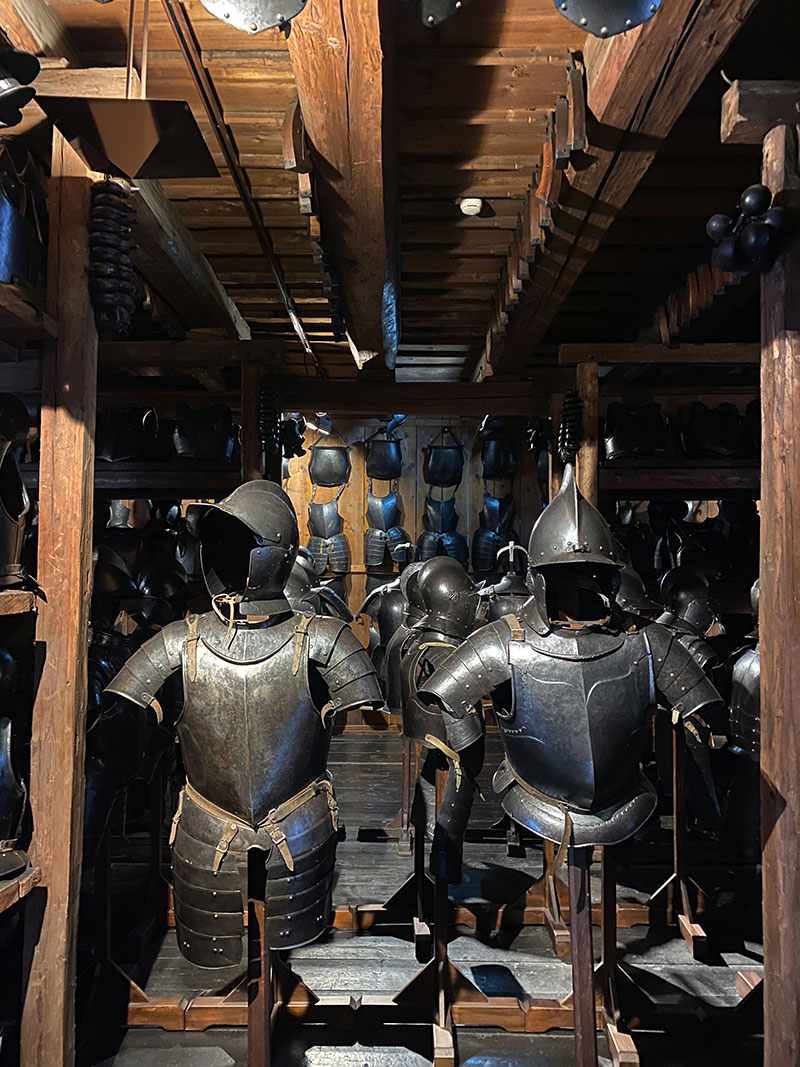
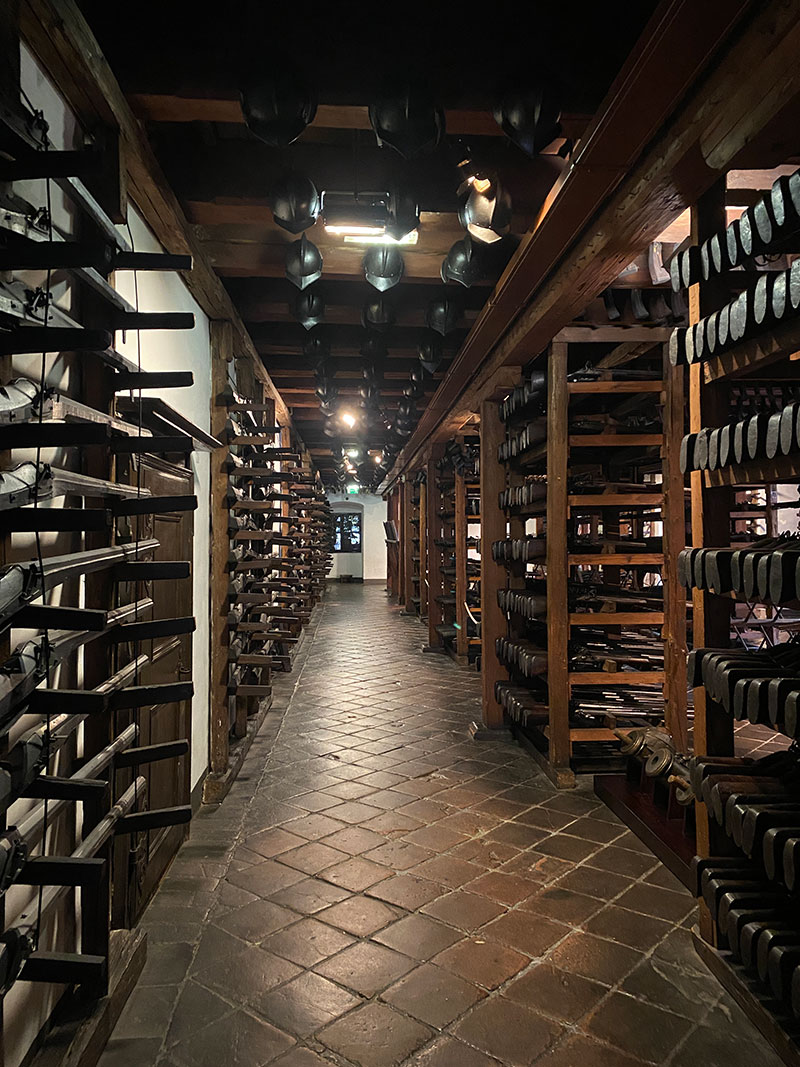
Enjoy Graz’s classic and contemporary music scene
You can’t mention Austria without thinking of the classical music scene, and Graz is no different, with its decadent – if slightly less so than Vienna or Salzburg – Opera House. But the classics, as with everything here, aren’t all that are represented, and the city has an ever-growing underground music scene. Jazz is also heavily featured in the annual concert schedule, which is unsurprising as Graz University was the first place to offer a dedicated jazz course in Europe.
In the summer, free jazz concerts take place on Wednesdays in the Old Town’s courtyards, providing some smooth tunes to compliment your Styrian wine. The city’s main classical concert event for over four decades is Styriarte, from late June until July. The programme has plenty of traditional performances in grand venues, but recently it’s modernised with some alternative scheduling, including lakeside concerts and event “Cycling Concerts”, which include five shorter performances in gorgeous spaces around Graz which are cycled between en-masse.

“With the cycle concerts, we can show a big part of the city in one concert. We have five positions, and we go by bicycle from position to position together with 80 bicycles through the streets and become the king of the traffic.”
–Mathis Huber, Intendant of Styriaarte
Watch the Carillon Glockenspiel dance
Time your visit to Glockenspielplatz square for 11am, 3pm, or 6pm, and you’ll be able to witness the Glockenspiels performance as it has been for over a century. On the hour, a bell melody rings out, and soon, two model dancers in traditional dress appear twirling above the balcony.
Tour Eggenberg Palace
Paid | Park open year-round, staterooms only in summer | Complimentary wheelchair rental, gravelled paths | Save on Google Maps
On the outskirts of the city, the Baroque Eggenberg Palace sits proudly in the centre of an extensive landscaped garden. While photos aren’t allowed inside, that doesn’t mean there’s nothing worth seeing – in fact, quite the opposite.
This palace complex is the second part of the city’s UNESCO World Heritage listing, making it one of the most popular things to do in Graz. Consisting of State Rooms, the Palace, and a couple of museums, the building was constructed in the 17th century as an opulent statement of political rule. Grand rooms adorned with extensive art lead from one to one, the magnificent ceiling paintings stealing the show.
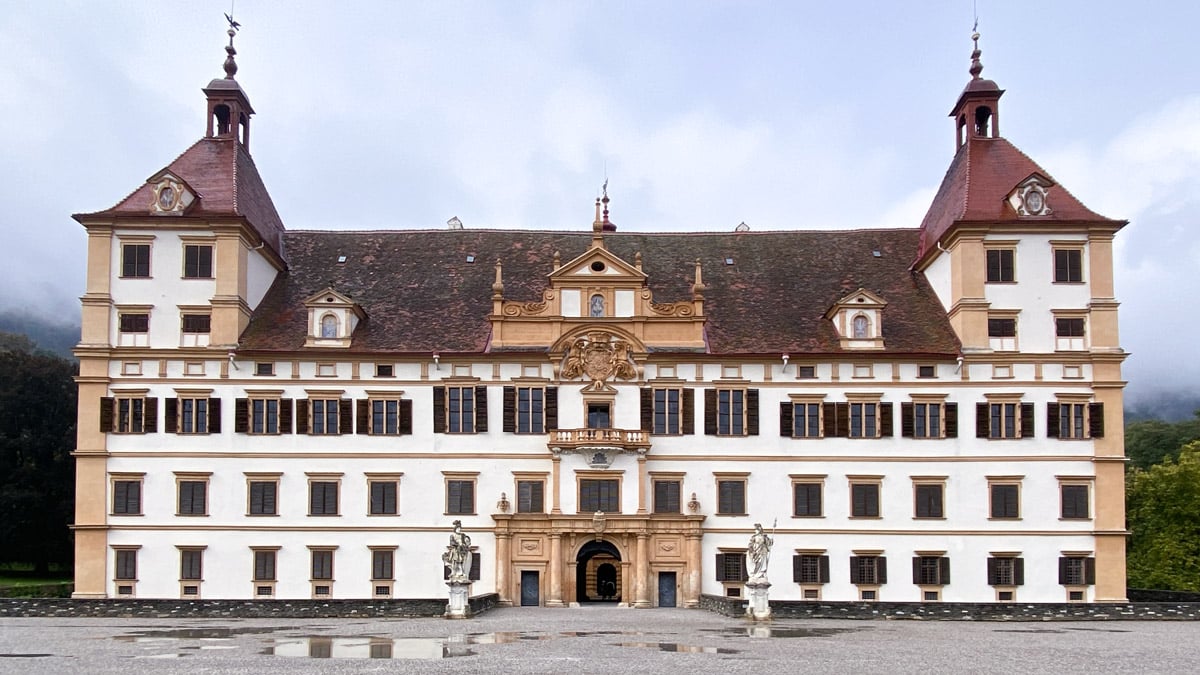
Peek at the Double Spiral Staircase
While this isn’t an attraction, I’d say to go out of your way for, if you’re near the Burg (the Styrian regional parliament), then this rare Double Spiral Staircase, from 1438, is worth a peek. Tucked away behind an entrance door you might think isn’t open to the public at first glance, this Gothic, twin-spiralling staircase is quite the achievement in design and stonemasonry – just prepare to feel a little dizzy as you climb up and down.
“We have five universities, we have an opera house, we have theatre, we have a vibrant city of design, we are the Genusshauptstadt [Capital of Culinary Delights] of Austria. For me, it’s just the right size.”
–Gabriele Blaschitz, Grazer Wein
See the Cathedral and it’s outdoor painting
Step inside the unassuming b exterior of Graz’s Cathedral, and you’ll be spellbound by the impressive frescoes, gilding and floor slabs. A former Imperial church constructed in the 15th century and later remodelled to become a cathedral in 1786, it’s by far one of Graz’s most impressive architectural buildings, blending Gothic and Baroque touches. Around the back, on the exterior and protected by glass, there is a magnificent fresco on the exterior wall – exit via the side door that goes to the external stairs to see it.
Appreciate the Botanical Gardens
Free | Open daily | Save on Google Maps
The Karl-Franzens-Universität botanical garden and greenhouses are as architecturally pleasing as you’d expect from the city. They are only a short bus ride away from the city and, while not huge, provide another nice green space to stroll around while appreciating the four different climate controlled areas housing international species.

Graz travel guide: things to do near Graz
If you’re spending a bit longer in Graz, you’ll likely want to head on some day trips. Luckily, there is plenty near the city itself, and with decent public buses and trains providing regular connections, these spots are easily visited. Here are just a few suggestions of the ample attractions nearby.

“In the west of Graz is Voitsberg, which is known for the Lipizzana horses That’s the breeding of the horses. They’re known in the Spanische Hofreitschule [Spanish Riding School] in Vienna. That’s where you can see them, but the young ones and the breeding happens in Styria. It’s just 45 minutes from here and you can go there and you can see the small Lipizzana horses.”
–Philip Florian, General Manager Parkhotel
Open Air Museum in Stuebing
Paid | Open March through October | Wheelchair accessible, gravel paths | Save on Google Maps
As one of the leading open-air museums in Europe – and Austria’s most extensive – this museum in Stuebing, just 20 minutes from the city, is a fascinating trip into the country’s past and one of the best things to do in Austria in summer.
With around 100 traditional houses relocated and rebuilt here, some dating back as far as the 13th century, the grounds are a great place to see how Austria’s alpine and farmland communities used to live. If you want to learn more about each building, pick up an English-printed guide from the entrance or join a guided tour to get the best of the experience; otherwise, just stroll freely between the mainly wooden homes.
With some ‘interactive’ elements to the park, such as actors doing traditional handicrafts or operating the ‘old shops’, on certain days, I think this would be a fun option to keep kids entertained while learning about Austria’s history.
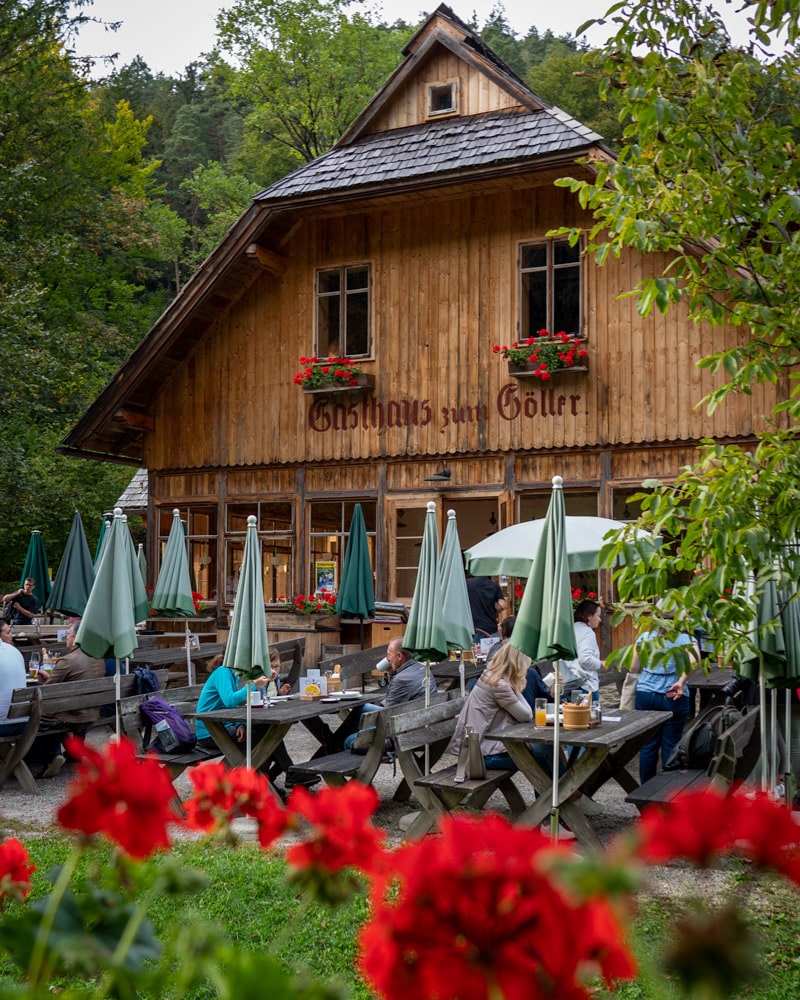
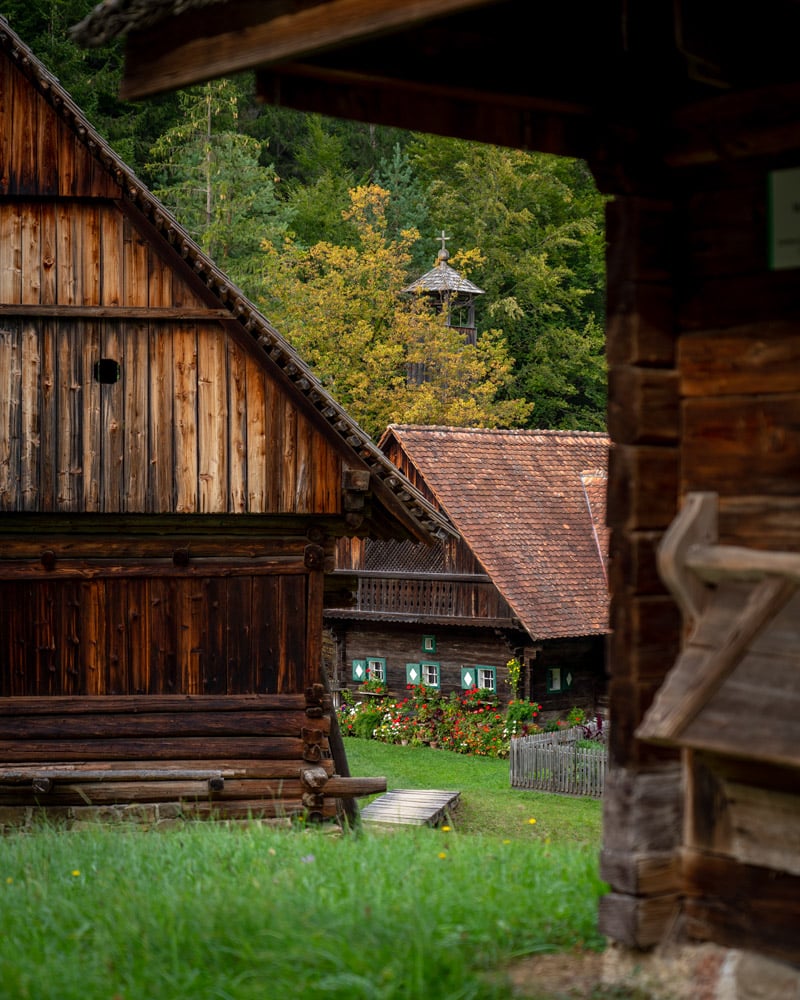
Styrian Wine Roads
Linking together some of the best of the local wineries, the Styrian Wine Roads are a network of routes which lead you through fertile farmlands and vines to the good stuff. Designated drivers will likely be needed for this one, although if you just want to visit one vineyard, it’s possible on public transport.

“Go to Sommeralm. It’s northeast of Graz. It’s a pasture. It’s really nice, it’s quiet there, and the cows are just everywhere – it’s beautiful and high up.”
–Eva Berghofer, Owner Coffee Ride
Cistercian Monastery in Rein
Paid | Guided tour | Mostly wheelchair accessible | Save on Google Maps
If you’d rather skip the countryside and dive into the architecture, then Rein Abbey, dating back to 1129, is a great place to head and one of the top things to do in Graz’s nearby surroundings. Boasting the title of the world’s oldest Cistercian abbey, the monastery is still in use by both monks, who are hidden away, and also as a secular school. Thus, you’ll need to join a guided tour to visit all the rooms, but it’s more than worth it.
The library is an absolute literacy dream, with plenty of Mediaeval manuscripts, while the interior of the Baroque church is an overload of colour and decoration – ask about the wine used to decorate the walls; it’s a rather interesting fact.
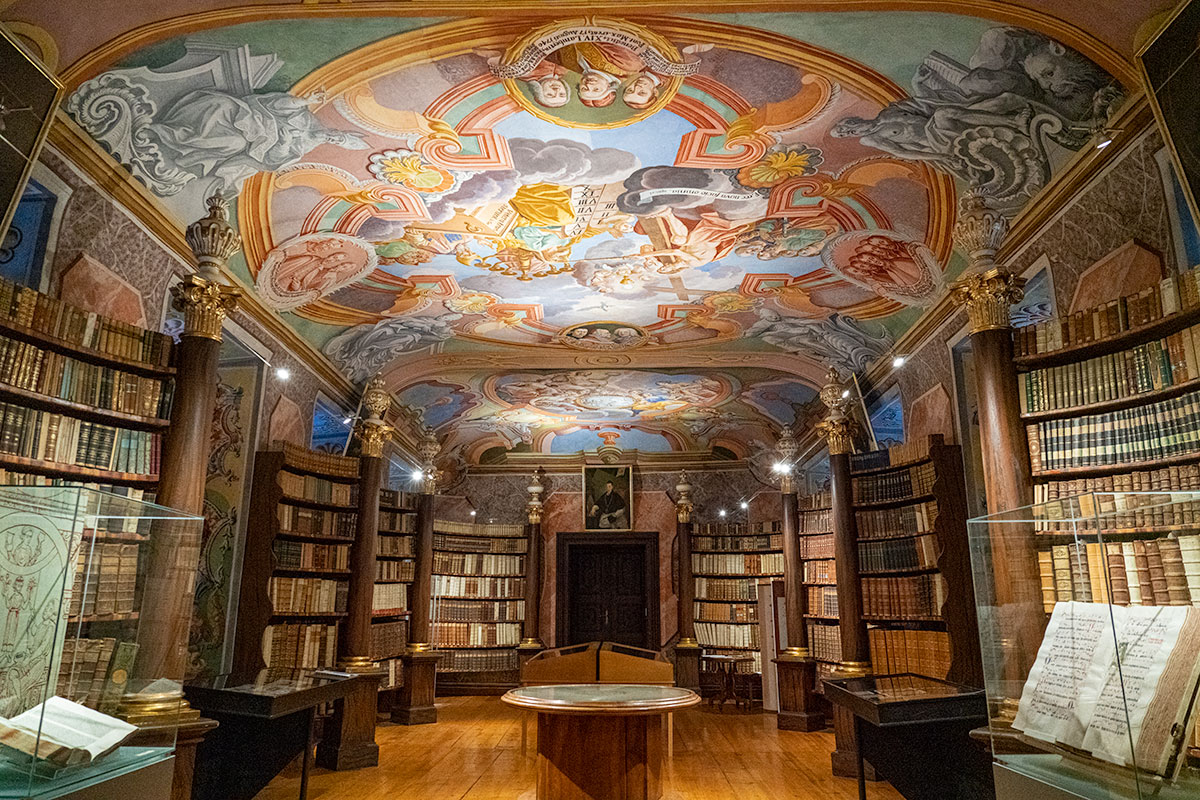
Where (and what) to eat in Graz
Graz’s food scene is excellent and one of Europe’s best. I could write a whole Graz travel guide just about gastronomy. Often touted as the best destination in Austria for cuisine, you won’t struggle to find a good meal at a fair price. The city’s foodie credentials are vast, which have earned it the title of ‘Culinary Capital of Austria’ within the nation’s borders.
Look out for the ‘Genuss Hauptstadt’ mark on restaurant doors, which shows the products are regional and well-sourced and keep an eye out for local food events during your visit. The most famous, the Long Table of Graz, which sees some 700-plus people dining together outside, requires a fair bit of advance planning. Here are some of my favourite restaurants I’ve eaten at in Graz.
Styrian specialities
Framing the city are the fertile farmlands of Graz, famed for various delicious seasonal products. Items to keep an eye out for are pumpkin seed oil, which is extra flavourful due to the type and climate, small and delicious alpine strawberries (Steirische Walderdbeeren), and Vulcano ham, from the volcanic lands near the city. There are plenty of farmers’ markets in and around the city that are ideal for picking up local specialties.
Mohrenwirt
This dimly lit and cosy Lend gem is one of my favourite restaurants in Graz and is worth the splurge. The menu is inventive and creative and very focused on locally sourced produce. In fact, the front pages are dedicated to telling you about all the suppliers, from where the beef was reared and which baker produced the bread to details on the co-operative who weave their chicken serving baskets. Be sure to book ahead!
Café König
If you’re craving a coffee and a sweet treat, old-world Café König is the place to go. Opposite opulent Palais Attems, a former publishing houses, many of Austria’s best writers and authors have paused and worked in this adorable cafe where coffee comes on traditional silver plates and the cakes are all so delicious looking it’s almost impossible to pick one.
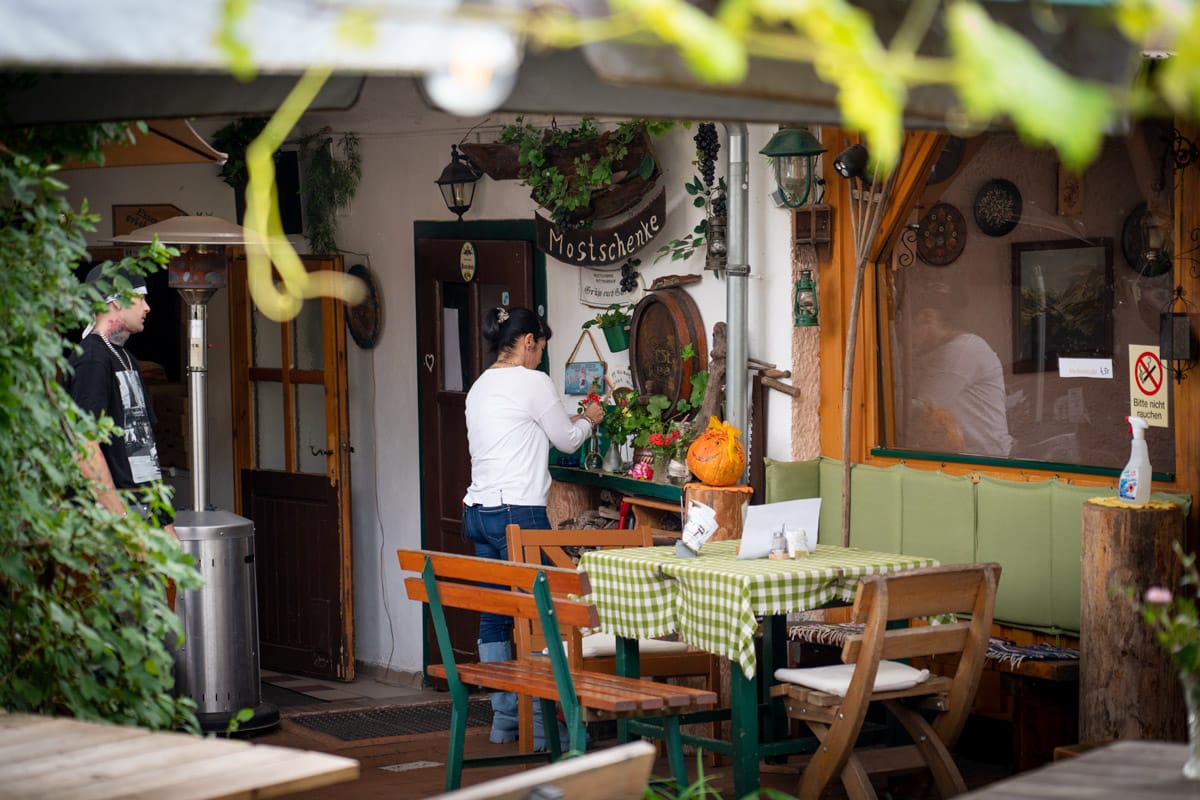
Buschenschanks
Outside the city centre, heading towards the Styrian wine country, you’ll find these rustic inn-style spots where wine is the star of the show. A long-running tradition, these garden-based and usually single-room drinking spots offer the chance to taste farm products and wines directly from the growers, though licensing restricts the kinds of food they can sell, so expect cold cuts paired with a recent harvest rather than anything cooked and hearty. Fattingerhof is a good option not far from the city, where you’ll also find a bio-shop selling all the farm’s products, such as jams and wines, to take home with you.

“I would recommend [cycling to] the south of Graz. Go to the Buschenschank Bockmoar. You’ll ride for around one and a half hours and then come by a nice lake, the Badesee Wildon, and then it goes steep up to the Puschenschank, which is in the hills, and it’s just a very nice place.”
–Jonathan Strallegger, Founder VeloFood
El Pescador
Graz has plenty of meat-based and vegetarian restaurants, but if you’re craving fish or seafood, lively El Pescador is the place to be. Usually packed, it’s worth reserving a table to enjoy excellently prepared fish dishes, many of which have a Croatian or Balkan twist, such as the shrimp ćevapi, a minced preparation method usually reserved for meat.
Die Hummel
My absolute favourite restaurant in Graz and one of the best meals I’ve had in a long time, Die Hummel is a zero-waste concept focuses on delicious Levantine cuisine. For those unfamiliar with the menu, the Levant is the historical Ottoman area roughly covering Jordan, Lebanon and Syria. Expec a table loaded with countless small mezze-like plates. With a constantly changing menu to ensure little to no food waste and plenty of green credentials, this women-led restaurant is a must-visit in Graz.

Restaurant Florian
Inside Parkhotel, this glorious restaurant will take you back to times of splendour. There’s a formal dining room, some delightful al fresco tables around the rose garden, and a limited, luxury tasting menu experience offered a few days of the week in a separate and exclusive space. The main menu focuses on traditional Austrian and Styrian dishes, and with one of the main chefs having worked here for four decades, you can be sure they have perfected their craft.
Stammtisch am Paulustor
You can’t go wrong here for fine dining in a fanciful setting. There’s an exquisite multi-course set menu with pairing if you want to go all out or an à la carte menu for a less indulgent (on the stomach and the wallet) option.
Der Steirer
This family-owned chain restaurant has a few spots in Austria, mainly in Vienna and Graz. It’s a funky affair, with plenty of wine lining the shelves and bare wooden tables. If you want to try Backhendl – a local fried chicken speciality – this is the place to do so.
Velofood
If you’re self-catering and fancy a takeaway, forget about all the other delivery apps and order with Velofood. Founded by Graz local Jonathan Strallegger in 2016, the company works with select restaurants in Graz that use biodegradable packaging and operate to high standards. Some also now offer fully reusable packaging inline.

Where to drink in Graz
Coffee Ride
For your morning coffee fix, be sure to visit Eva, the friendly and chatty owner of Coffee Ride. This small, cosy coffee shop with a cobbled terrace opposite Graz’s Franciscan Church is something of a central hub for cyclists and coffee enthusiasts. Come for an excellent espresso and slice of Eva’s decadent and homemade chocolate cakes and ask her about any upcoming events – she often runs community coffee rides and even bike dating events which can be a really nice opportunity to meet more of Graz’s residents.

“I organise a coffee ride every Sunday, two different groups, one 50k and one 100k. The 50k is an easy beginner-friendly ride, and the 100k is a motivated coffee ride where you also, if you’re not fast enough where you can stop.”
–Eva Berghofer, Owner Coffee Ride
noël
Look for the misspelt ‘Nigth-Club’ sign out front of this red, ex-brothel building, and head inside for some masterfully mixed cocktails and a boohoo vibe in the intimate neon-lit room.
Kastner & Öhler’s Rooftop Bar
A long-loved department store in the centre of the Old Town, the rooftop bar here is the place to come for a Spritz (the lavender one is incredible) at sunset, although opening hours vary seasonally.
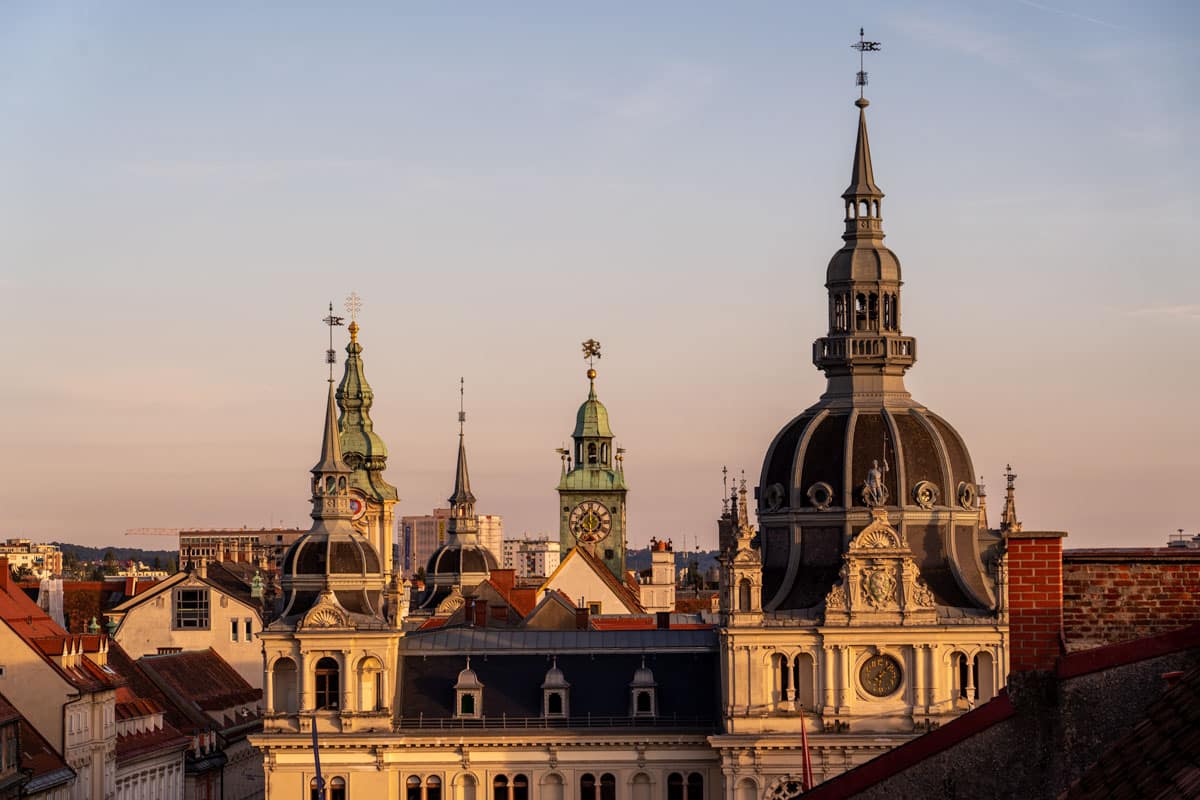
The Running Horse
Behind the unassuming crimson walls, this dimly lit, slightly dingy pub with wooden tables and graffiti-adorned bathrooms provides a proper pint. There are plenty of regional and international craft beers available, and it stays open late, offering a great spot for a late night drink without blaring music.
Schlossberg Biergarten
There are a few places to grab a drink at the top of Graz, but I really liked this garden’s laid-back vibes and great views.

“It’s such a beautiful place to live in for me because it’s also the countryside, almost everything you have within one hour’s drive by car. You have in the south the “Tuscany of Styria”, that’s how we call it because it’s full of wine and wineries and it’s very famous in Austria.”
–Philip Florian, General Manager Parkhotel
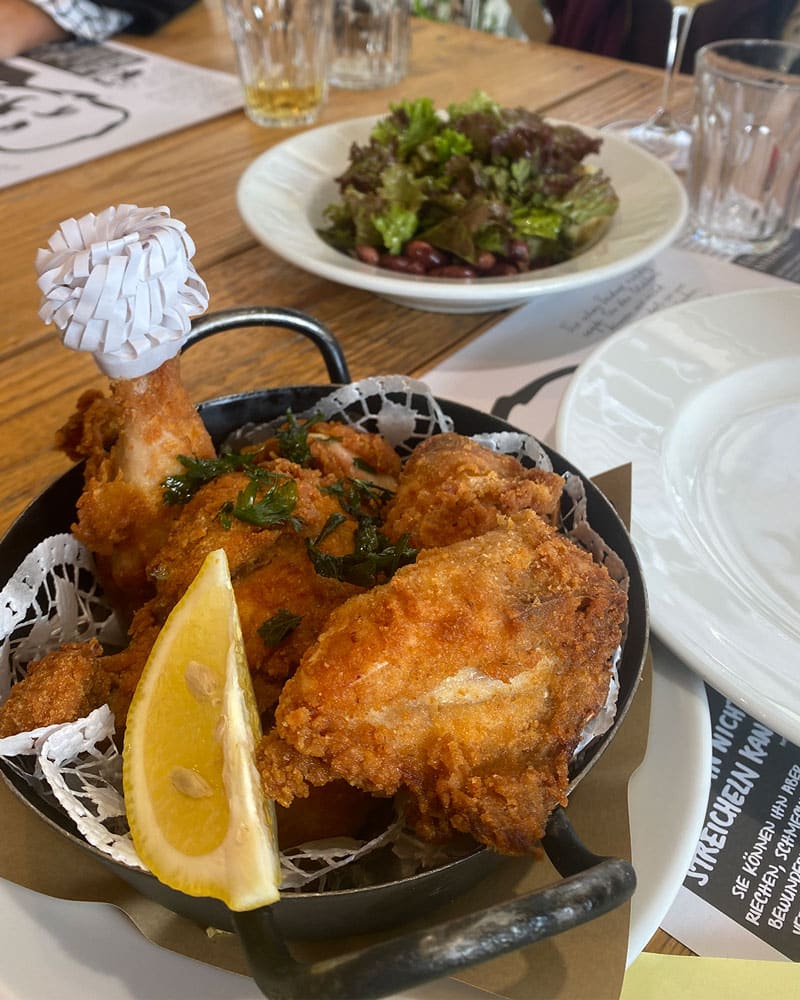
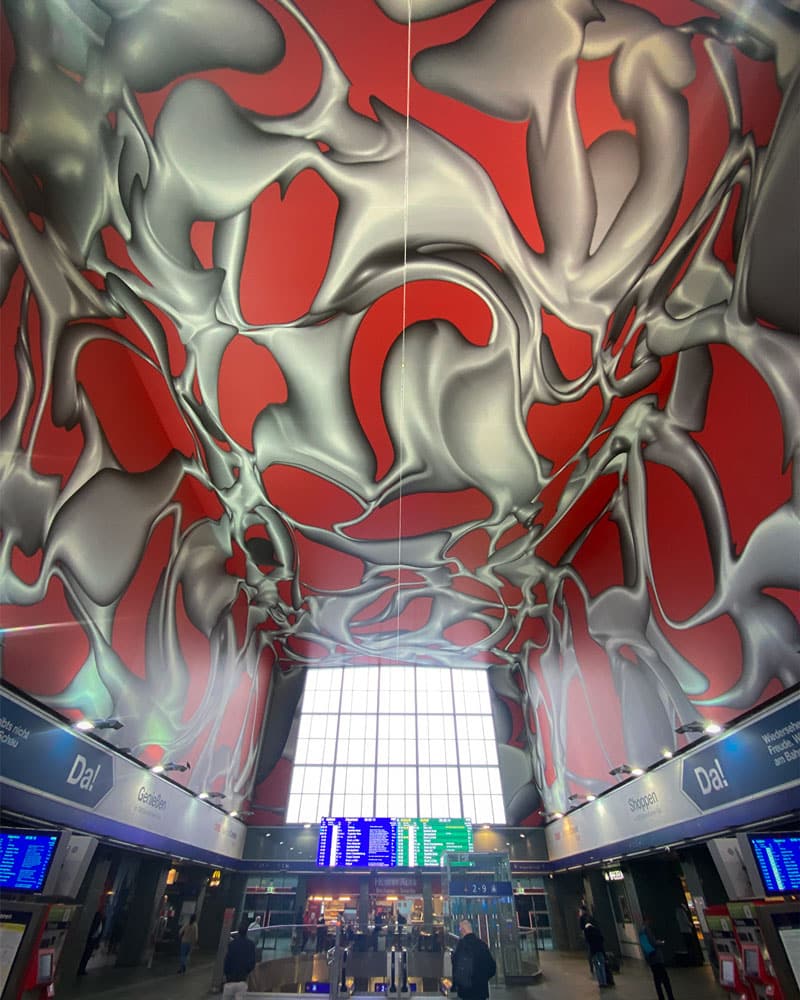
Where to shop in Graz
Graz hasn’t been overwhelmed by chain stores and tacky souvenir shops, and buying local is very much a point of pride for many of the city’s citizens. Whether you want to pack your bag with local delicacies such as Pumpkin Oil or unique designer items, there are plenty of boutiques and independent stores to choose from. These are a few of my favourites.
Offline Retail
Combining both a social impact project and vintage clothing, Offline Retail is not only a place to find premium second-hand clothes but also to support employment and upskilling opportunities. Established to provide training and jobs for those who have found themselves in a situation of struggle, it provides a positive impact on both the environment and project participants.

“What we really like about this market are all those little bars around the edge. On a summer evening, people meet friends, skate, enjoy music and even take salsa classes.”
–Ruth Nezmahen, Discover Graz
Hofbäckerei Edegger-Tax
I really enjoyed my visits to this farmers’ market, which is open from 6 am until 1 pm on weekdays and Saturdays. While it’s mainly fresh produce, you’ll find some of the stalls selling items to take away, such as local wines and pumpkin oil, and it’s nice to be able to buy directly from the producers and cut out the middleman.
In operation since 1569 (although only in its current location since the 19th century), this is Graz’s oldest bakery. Its wonderfully storied wooden facade is only the start of its charm. Inside, you can pick up (or pause at the few seats) delicious local cakes such as apple straddle, first-class freshly baked bread, and local biscuits.
Bauernmarkt Lendplatz
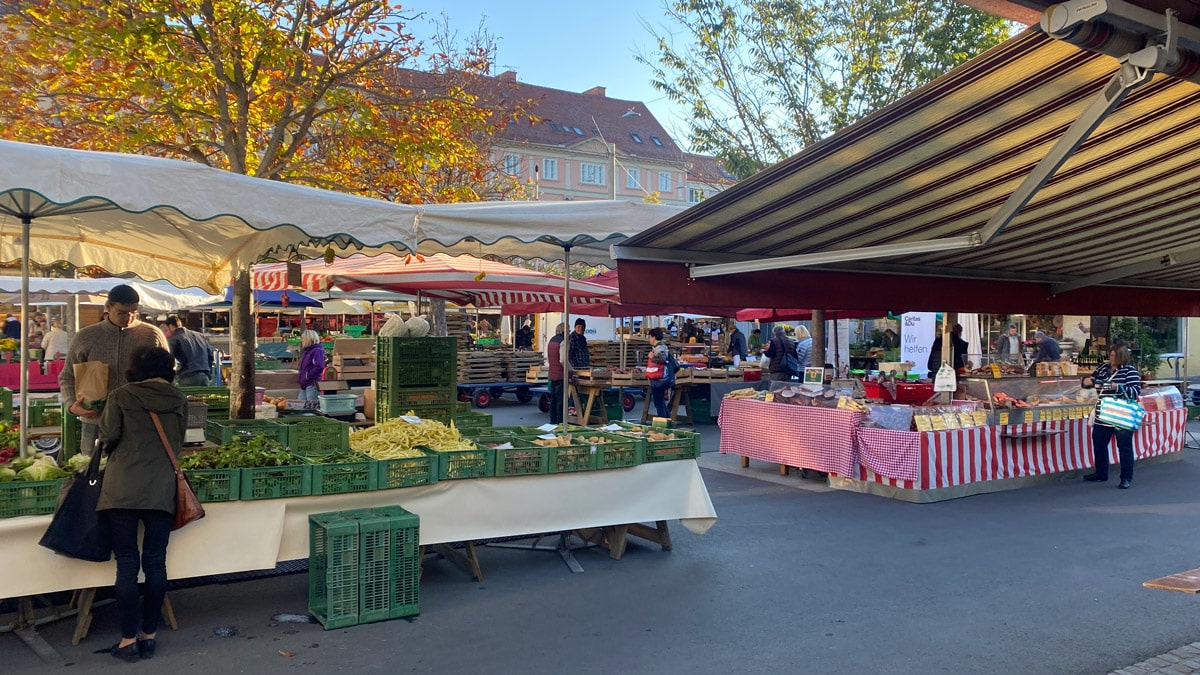
TAG Werk
Bags crafted from recycled materials are the main focus of TAG Werk, a small boutique in the Lend district. Not only are the products helping reduce waste, but the shop serves a great purpose as a youth employment project, although the designs more than speak for themselves.
Gries and Lind’s Artisanal Stores
One of the best places to head for unique finds, handcrafted products, and second-hand clothes is across the river in the Gries and Lind districts. You can find plenty of independent stores here, many of which have an upcycling theme.

“Until recently, these two districts [Lend and Gries] had a really bad reputation. My grandmother in law warned me about moving here. Gentrification has happened in Lend and the prices are getting higher and it will change but Gries still has that reputation, especially amongst older people.”
–Ruth Nezmahen, Discover Graz
Moser Books
I’m a sucker for bookshops, and this multi-floored literary hideout is a joy to browse. While, of course, the majority of books are in German, you’ll also find a decent selection of English and other language reads. It’s an excellent place to pick up translated works written by local writers, such as Peter Rosegger or Peter Handke (who once wrote for a local publication in Graz), whose Repetition, a novel about his journey into Slovenia, I thoroughly enjoyed.
Peaces
A little outside the city centre (you’ll need a car) is Peaces, the shop of Susanne Huber. Focusing on plant-inspired screen-printed clothes, all of her products are organic and fair trade, mainly using Austrian linen and cotton. Susanne also produces clothes from Tencel, a kind of wood fabric hailing from the Austrian city of Linz.
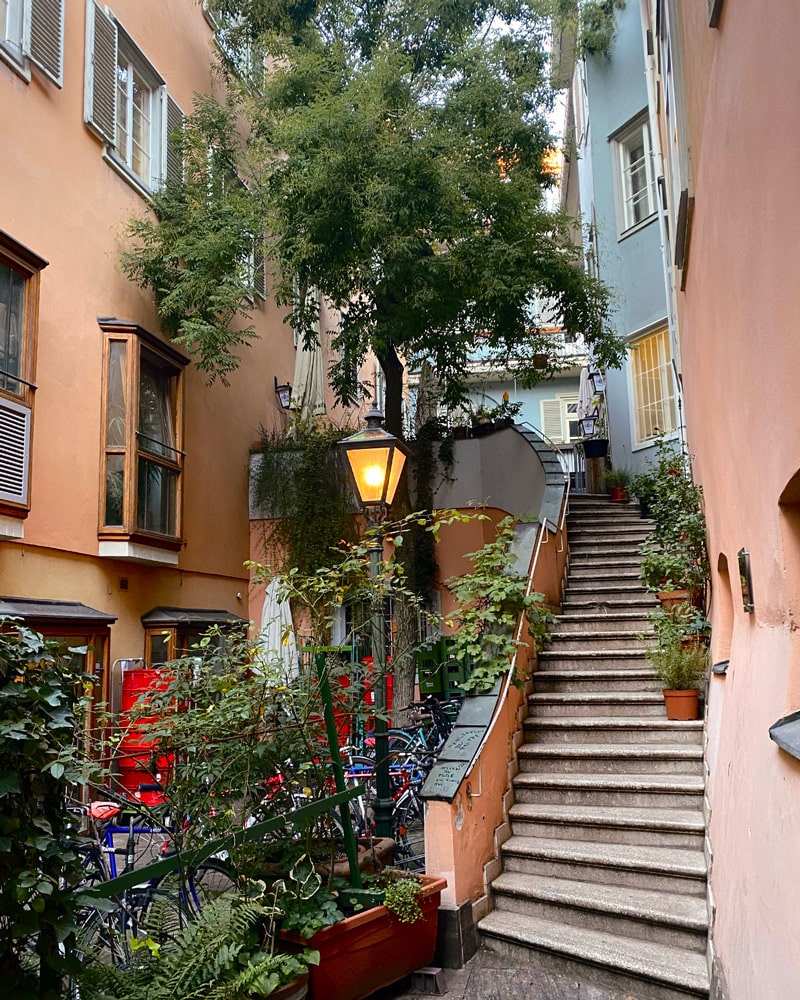
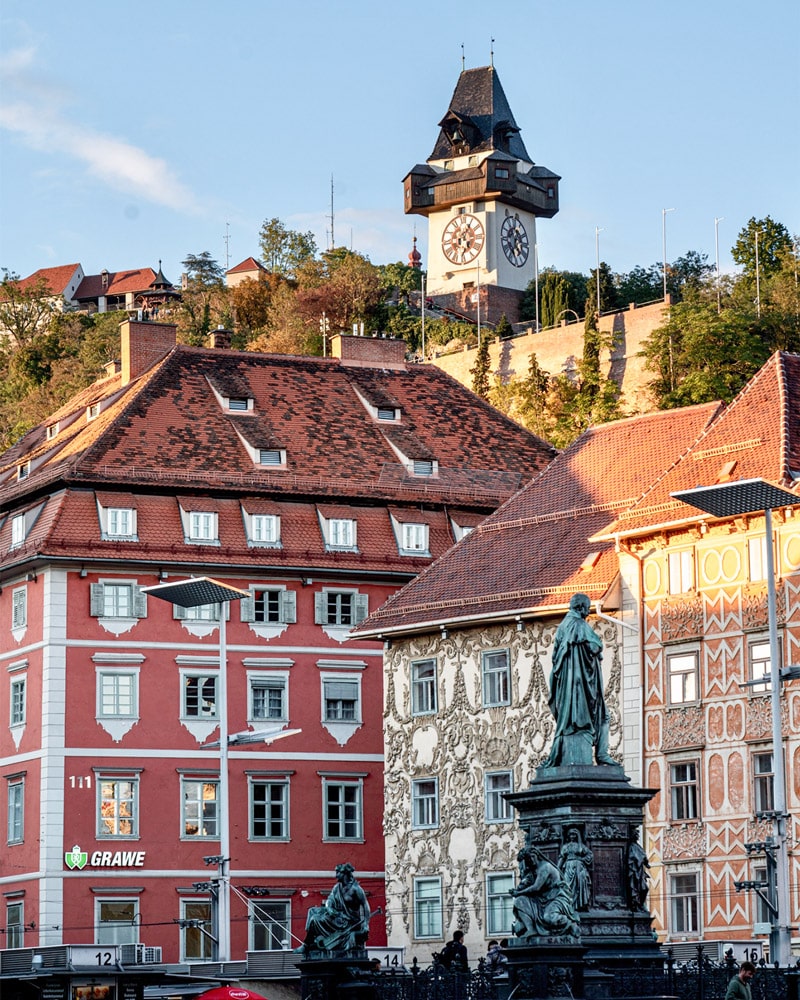
How to get to Graz
Perhaps one of the reasons Graz has remained less touristy than Austria’s more famous cities is the lack of direct flights. This makes it slightly harder to reach from afar, although the reward is in the less crowded streets than, say, Salzburg. Still, getting to Graz doesn’t need to be that difficult.
Flight free from the UK
To reach Graz from London without flying, you’ll need to allow nearly a full day of travel. The quickest and most expensive option is to travel by train from London, starting on the Eurostar. Going via Paris and then Germany will take around 16 hours and involve nearly a handful of changes. If you head to Brussels in Belgium instead, you can connect with the ÖBB (Austrian Rail) run sleeper train to Vienna and then take a local connection to Graz. This is a good choice if you’d rather sleep through part of the journey and arrive a bit more rested.
By bus, the journey will be longer but cheaper, so you might want to consider stopping somewhere else on the way. A combination of RegioJet and FlixBus is the way to go; just check for the most up-to-date schedules to plan where to stop and break up the journey. Alternatively, you can use the DFDS ferry from Dover to Calais and then continue your journey by bus on the mainland.
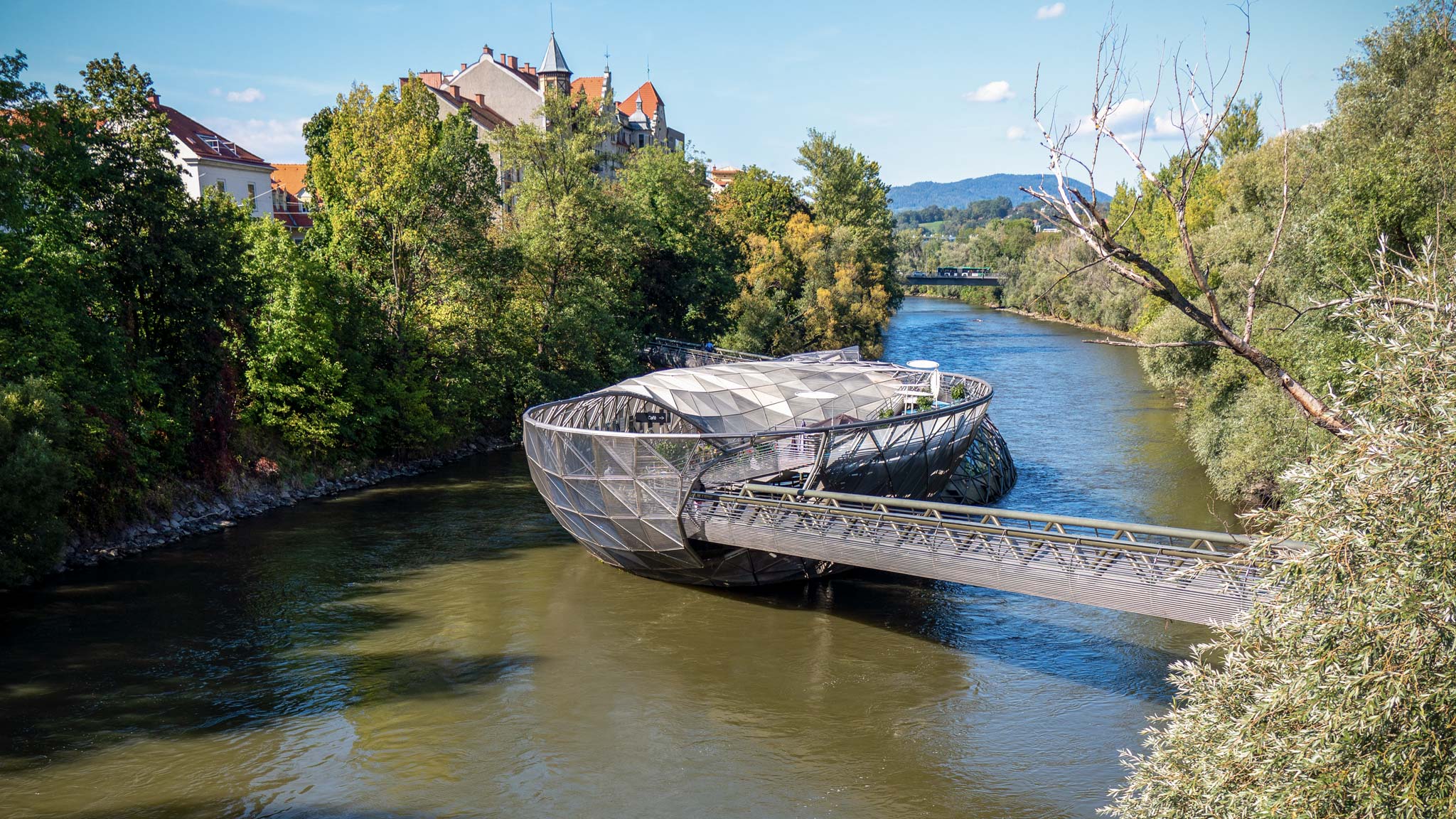
Flying to Graz
Graz’s relatively small airport (GRZ: Flughafen Graz) doesn’t have too many international connections, mainly servicing cities in Germany and The Netherlands, meaning a connecting flight with Lufthansa or KLM is likely if you want to travel by air. Direct flights between London are not currently listed on the 2023 schedule. Affordable and quick buses and trains connect the airport to the city.
Train connections
Graz has good train connections with neighbouring countries and nearby cities. For example, I travelled to Graz by train from South Bohemia, Czech Republic and departed on a night train to Italy, connecting via nearby Bruck/Mur. If you’re already in Austria, then trains from Vienna (2:30 hours, direct ) and Salzburg (4 hours, direct ) are regular and reliable. For the best fares, book in advance or consider using FlixBus as a slightly cheaper alternative.
How to get around Graz
Getting around Graz is a breeze. It’s a relatively compact city and easily explored on foot. The only steep part of the city you’ll encounter is when climbing to the Schlossberg, though there is an elevator up and even a slide down. Cycling in Graz is also an excellent option due to the extensive cycle paths in and beyond the city.
In the core of the Old Town, the pedestrianised streets are a delight to explore, as are the maze of courtyards. If you want a break from strolling, hop on one of the trams. Between Hauptplatz and Jakominiplatz, the trams are free to use, with the included stations marked by a symbol. Outside of this area, tickets are affordable and can be purchased at machines or are also complementary if you’ve purchased a Graz Card.

“My colleagues come to work by cycling, and me too. We all are cyclists here in the city. We can do everything by cycling and by every weather – if we have one meter of snow, then I take the bus.”
–Mathis Huber, Intendant of Styriaarte
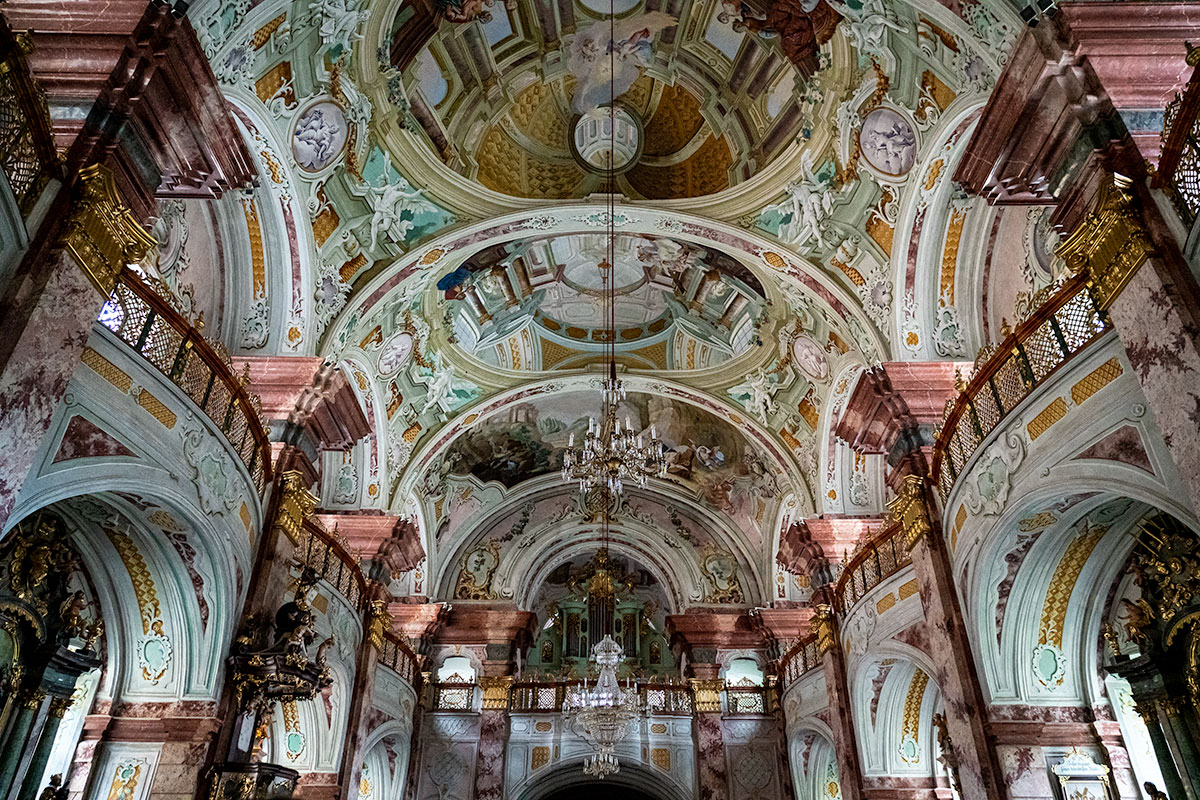
Best time to visit Graz
The best time to visit Graz for the most reliable weather is between May and September. In summer, daytime temperatures are usually around 26°C (79°F), dropping to 15°C (59°F) at night. That said, summer can be a little busy, making off-season travel in Spring or Autumn more attractive – particularly true during the autumn harvest (usually September through to late October).
With plenty of attractions in the city, a rainy winter visit can also be enjoyable – although, if you want to explore the surrounding countryside, you’ll want to skip these months. During December, you’ll have the bonus of the Old Town Christmas market.

“I’m so glad this isn’t bursting with tourists. Graz has got tourists, but it hasn’t gotten to the point where it’s uncomfortable. There are times of the year, like Christmas, when the core of the city, the medieval quarter, is busy, but you can still move around.”
–Helen Petermandl, Tour Guide
Where to travel in Austria beyond Graz
After Graz, why not explore the country’s capital city of Vienna, take in all the best things to do in Salzburg, or climb Austria’s best mountain trails to soak in the breathtaking nature?
Alternatively, as Austria is so well placed in the centre of the continent, you can easily hop on a train to explore more of Europe’s best hidden gems.

“It’s very cool to cycle here as you’re out of the city in just a few minutes. If you’re a beginner, it’s better to go along the river to the south or north. If you go west and east, it’s really hilly. You could even go south to Slovenia and then back with the train. ”
–Eva Berghofer, Owner Coffee Ride
This article was produced in partnership with Graz Tourism. All editorial content is, as always, my own.




Leave a Reply
Want to join the discussion?Feel free to contribute!